- Privacy Policy

Home » Term Paper – Format, Examples and Writing Guide

Term Paper – Format, Examples and Writing Guide
Table of Contents

Definition:
Term paper is a type of academic writing assignment that is typically assigned to students at the end of a semester or term. It is usually a research-based paper that is meant to demonstrate the student’s understanding of a particular topic, as well as their ability to analyze and synthesize information from various sources.
Term papers are usually longer than other types of academic writing assignments and can range anywhere from 5 to 20 pages or more, depending on the level of study and the specific requirements of the assignment. They often require extensive research and the use of a variety of sources, including books, articles, and other academic publications.
Term Paper Format
The format of a term paper may vary depending on the specific requirements of your professor or institution. However, a typical term paper usually consists of the following sections:
- Title page: This should include the title of your paper, your name, the course name and number, your instructor’s name, and the date.
- Abstract : This is a brief summary of your paper, usually no more than 250 words. It should provide an overview of your topic, the research question or hypothesis, your methodology, and your main findings or conclusions.
- Introduction : This section should introduce your topic and provide background information on the subject. You should also state your research question or hypothesis and explain the importance of your research.
- Literature review : This section should review the existing literature on your topic. You should summarize the key findings and arguments made by other scholars and identify any gaps in the literature that your research aims to address.
- Methodology: This section should describe the methods you used to collect and analyze your data. You should explain your research design, sampling strategy, data collection methods, and data analysis techniques.
- Results : This section should present your findings. You can use tables, graphs, and charts to illustrate your data.
- Discussion : This section should interpret your findings and explain what they mean in relation to your research question or hypothesis. You should also discuss any limitations of your study and suggest areas for future research.
- Conclusion : This section should summarize your main findings and conclusions. You should also restate the importance of your research and its implications for the field.
- References : This section should list all the sources you cited in your paper using a specific citation style (e.g., APA, MLA, Chicago).
- Appendices : This section should include any additional materials that are relevant to your study but not essential to your main argument (e.g., survey questions, interview transcripts).
Structure of Term Paper
Here’s an example structure for a term paper:
I. Introduction
A. Background information on the topic
B. Thesis statement
II. Literature Review
A. Overview of current literature on the topic
B. Discussion of key themes and findings from literature
C. Identification of gaps in current literature
III. Methodology
A. Description of research design
B. Discussion of data collection methods
C. Explanation of data analysis techniques
IV. Results
A. Presentation of findings
B. Analysis and interpretation of results
C. Comparison of results with previous studies
V. Discussion
A. Summary of key findings
B. Explanation of how results address the research questions
C. Implications of results for the field
VI. Conclusion
A. Recap of key points
B. Significance of findings
C. Future directions for research
VII. References
A. List of sources cited in the paper
How to Write Term Paper
Here are some steps to help you write a term paper:
- Choose a topic: Choose a topic that interests you and is relevant to your course. If your professor has assigned a topic, make sure you understand it and clarify any doubts before you start.
- Research : Conduct research on your topic by gathering information from various sources such as books, academic journals, and online resources. Take notes and organize your information systematically.
- Create an outline : Create an outline of your term paper by arranging your ideas and information in a logical sequence. Your outline should include an introduction, body paragraphs, and a conclusion.
- Write a thesis statement: Write a clear and concise thesis statement that states the main idea of your paper. Your thesis statement should be included in your introduction.
- Write the introduction: The introduction should grab the reader’s attention, provide background information on your topic, and introduce your thesis statement.
- Write the body : The body of your paper should provide supporting evidence for your thesis statement. Use your research to provide details and examples to support your argument. Make sure to organize your ideas logically and use transition words to connect paragraphs.
- Write the conclusion : The conclusion should summarize your main points and restate your thesis statement. Avoid introducing new information in the conclusion.
- Edit and proofread: Edit and proofread your term paper carefully to ensure that it is free of errors and flows smoothly. Check for grammar, spelling, and punctuation errors.
- Format and cite your sources: Follow the formatting guidelines provided by your professor and cite your sources properly using the appropriate citation style.
- Submit your paper : Submit your paper on time and according to the instructions provided by your professor.
Term Paper Example
Here’s an example of a term paper:
Title : The Role of Artificial Intelligence in Cybersecurity
As the world becomes more digitally interconnected, cybersecurity threats are increasing in frequency and sophistication. Traditional security measures are no longer enough to protect against these threats. This paper explores the role of artificial intelligence (AI) in cybersecurity, including how AI can be used to detect and respond to threats in real-time, the challenges of implementing AI in cybersecurity, and the potential ethical implications of AI-powered security systems. The paper concludes with recommendations for organizations looking to integrate AI into their cybersecurity strategies.
Introduction :
The increasing number of cybersecurity threats in recent years has led to a growing interest in the potential of artificial intelligence (AI) to improve cybersecurity. AI has the ability to analyze vast amounts of data and identify patterns and anomalies that may indicate a security breach. Additionally, AI can automate responses to threats, allowing for faster and more effective mitigation of security incidents. However, there are also challenges associated with implementing AI in cybersecurity, such as the need for large amounts of high-quality data, the potential for AI systems to make mistakes, and the ethical considerations surrounding the use of AI in security.
Literature Review:
This section of the paper reviews existing research on the use of AI in cybersecurity. It begins by discussing the types of AI techniques used in cybersecurity, including machine learning, natural language processing, and neural networks. The literature review then explores the advantages of using AI in cybersecurity, such as its ability to detect previously unknown threats and its potential to reduce the workload of security analysts. However, the review also highlights some of the challenges associated with implementing AI in cybersecurity, such as the need for high-quality training data and the potential for AI systems to be fooled by sophisticated attacks.
Methodology :
To better understand the challenges and opportunities associated with using AI in cybersecurity, this paper conducted a survey of cybersecurity professionals working in a variety of industries. The survey included questions about the types of AI techniques used in their organizations, the challenges they faced when implementing AI in cybersecurity, and their perceptions of the ethical implications of using AI in security.
The results of the survey showed that while many organizations are interested in using AI in cybersecurity, they face several challenges when implementing these systems. These challenges include the need for high-quality training data, the potential for AI systems to be fooled by sophisticated attacks, and the difficulty of integrating AI with existing security systems. Additionally, many respondents expressed concerns about the ethical implications of using AI in security, such as the potential for AI to be biased or to make decisions that are harmful to individuals or society as a whole.
Discussion :
Based on the results of the survey and the existing literature, this paper discusses the potential benefits and risks of using AI in cybersecurity. It also provides recommendations for organizations looking to integrate AI into their security strategies, such as the need to prioritize data quality and to ensure that AI systems are transparent and accountable.
Conclusion :
While there are challenges associated with implementing AI in cybersecurity, the potential benefits of using these systems are significant. AI can help organizations detect and respond to threats more quickly and effectively, reducing the risk of security breaches. However, it is important for organizations to be aware of the potential ethical implications of using AI in security and to take steps to ensure that these systems are transparent and accountable.
References:
- Alkhaldi, S., Al-Daraiseh, A., & Lutfiyya, H. (2019). A Survey on Artificial Intelligence Techniques in Cyber Security. Journal of Information Security, 10(03), 191-207.
- Gartner. (2019). Gartner Top 10 Strategic Technology Trends for 2020. Retrieved from https://www.gartner.com/smarterwithgartner/gartner-top-10-strategic-technology-trends-for-2020/
- Kshetri, N. (2018). Blockchain’s roles in meeting key supply chain management objectives. International Journal of Information Management, 39, 80-89.
- Lipton, Z. C. (2018). The mythos of model interpretability. arXiv preprint arXiv:1606.03490.
- Schneier, B. (2019). Click Here to Kill Everybody: Security and Survival in a Hyper-Connected World. WW Norton & Company.
- Wahab, M. A., Rahman, M. S., & Islam, M. R. (2020). A Survey on AI Techniques in Cybersecurity. International Journal of Scientific & Engineering Research, 11(2), 22-27.
When to Write Term Paper
A term paper is usually a lengthy research paper that is assigned to students at the end of a term or semester. There are several situations when writing a term paper may be required, including:
- As a course requirement: In most cases, a term paper is required as part of the coursework for a particular course. It may be assigned by the instructor as a way of assessing the student’s understanding of the course material.
- To explore a specific topic : A term paper can be an excellent opportunity for students to explore a specific topic of interest in-depth. It allows them to conduct extensive research on the topic and develop their understanding of it.
- To develop critical thinking skills : Writing a term paper requires students to engage in critical thinking and analysis. It helps them to develop their ability to evaluate and interpret information, as well as to present their ideas in a clear and coherent manner.
- To prepare for future academic or professional pursuits: Writing a term paper can be an excellent way for students to prepare for future academic or professional pursuits. It can help them to develop the research and writing skills necessary for success in higher education or in a professional career.
Purpose of Term Paper
The main purposes of a term paper are:
- Demonstrate mastery of a subject: A term paper provides an opportunity for students to showcase their knowledge and understanding of a particular subject. It requires students to research and analyze the topic, and then present their findings in a clear and organized manner.
- Develop critical thinking skills: Writing a term paper requires students to think critically about their subject matter, analyzing various sources and viewpoints, and evaluating evidence to support their arguments.
- Improve writing skills : Writing a term paper helps students improve their writing skills, including organization, clarity, and coherence. It also requires them to follow specific formatting and citation guidelines, which can be valuable skills for future academic and professional endeavors.
- Contribute to academic discourse : A well-written term paper can contribute to academic discourse by presenting new insights, ideas, and arguments that add to the existing body of knowledge on a particular topic.
- Prepare for future research : Writing a term paper can help prepare students for future research, by teaching them how to conduct a literature review, evaluate sources, and formulate research questions and hypotheses. It can also help them develop research skills that they can apply in future academic or professional endeavors.
Advantages of Term Paper
There are several advantages of writing a term paper, including:
- In-depth exploration: Writing a term paper allows you to delve deeper into a specific topic, allowing you to gain a more comprehensive understanding of the subject matter.
- Improved writing skills: Writing a term paper involves extensive research, critical thinking, and the organization of ideas into a cohesive written document. As a result, writing a term paper can improve your writing skills significantly.
- Demonstration of knowledge: A well-written term paper demonstrates your knowledge and understanding of the subject matter, which can be beneficial for academic or professional purposes.
- Development of research skills : Writing a term paper requires conducting thorough research, analyzing data, and synthesizing information from various sources. This process can help you develop essential research skills that can be applied in many other areas.
- Enhancement of critical thinking : Writing a term paper encourages you to think critically, evaluate information, and develop well-supported arguments. These skills can be useful in many areas of life, including personal and professional decision-making.
- Preparation for further academic work : Writing a term paper is excellent preparation for more extensive academic projects, such as a thesis or dissertation.
About the author
Muhammad Hassan
Researcher, Academic Writer, Web developer
You may also like

Researcher – How to become a Researcher

What is History – Definitions, Periods, Methods

Academic Paper – Format, Example and Writing...

What is Economics – Definition, Methods, Types

What is Archaeology – Definition and Overview

Physicist – Definition, Types and Work Area
- Google Slides Presentation Design
- Pitch Deck Design
- Powerpoint Redesign
- Other Design Services

- Guide & How to's
How to present a research paper in PPT: best practices
A research paper presentation is frequently used at conferences and other events where you have a chance to share the results of your research and receive feedback from colleagues. Although it may appear as simple as summarizing the findings, successful examples of research paper presentations show that there is a little bit more to it.
In this article, we’ll walk you through the basic outline and steps to create a good research paper presentation. We’ll also explain what to include and what not to include in your presentation of research paper and share some of the most effective tips you can use to take your slides to the next level.
Research paper PowerPoint presentation outline
Creating a PowerPoint presentation for a research paper involves organizing and summarizing your key findings, methodology, and conclusions in a way that encourages your audience to interact with your work and share their interest in it with others. Here’s a basic research paper outline PowerPoint you can follow:
1. Title (1 slide)
Typically, your title slide should contain the following information:
- Title of the research paper
- Affiliation or institution
- Date of presentation
2. Introduction (1-3 slides)
On this slide of your presentation, briefly introduce the research topic and its significance and state the research question or objective.
3. Research questions or hypothesis (1 slide)
This slide should emphasize the objectives of your research or present the hypothesis.
4. Literature review (1 slide)
Your literature review has to provide context for your research by summarizing relevant literature. Additionally, it should highlight gaps or areas where your research contributes.
5. Methodology and data collection (1-2 slides)
This slide of your research paper PowerPoint has to explain the research design, methods, and procedures. It must also Include details about participants, materials, and data collection and emphasize special equipment you have used in your work.
6. Results (3-5 slides)
On this slide, you must present the results of your data analysis and discuss any trends, patterns, or significant findings. Moreover, you should use charts, graphs, and tables to illustrate data and highlight something novel in your results (if applicable).
7. Conclusion (1 slide)
Your conclusion slide has to summarize the main findings and their implications, as well as discuss the broader impact of your research. Usually, a single statement is enough.
8. Recommendations (1 slide)
If applicable, provide recommendations for future research or actions on this slide.
9. References (1-2 slides)
The references slide is where you list all the sources cited in your research paper.
10. Acknowledgments (1 slide)
On this presentation slide, acknowledge any individuals, organizations, or funding sources that contributed to your research.
11. Appendix (1 slide)
If applicable, include any supplementary materials, such as additional data or detailed charts, in your appendix slide.
The above outline is just a general guideline, so make sure to adjust it based on your specific research paper and the time allotted for the presentation.
Steps to creating a memorable research paper presentation
Creating a PowerPoint presentation for a research paper involves several critical steps needed to convey your findings and engage your audience effectively, and these steps are as follows:
Step 1. Understand your audience:
- Identify the audience for your presentation.
- Tailor your content and level of detail to match the audience’s background and knowledge.
Step 2. Define your key messages:
- Clearly articulate the main messages or findings of your research.
- Identify the key points you want your audience to remember.
Step 3. Design your research paper PPT presentation:
- Use a clean and professional design that complements your research topic.
- Choose readable fonts, consistent formatting, and a limited color palette.
- Opt for PowerPoint presentation services if slide design is not your strong side.
Step 4. Put content on slides:
- Follow the outline above to structure your presentation effectively; include key sections and topics.
- Organize your content logically, following the flow of your research paper.
Step 5. Final check:
- Proofread your slides for typos, errors, and inconsistencies.
- Ensure all visuals are clear, high-quality, and properly labeled.
Step 6. Save and share:
- Save your presentation and ensure compatibility with the equipment you’ll be using.
- If necessary, share a copy of your presentation with the audience.
By following these steps, you can create a well-organized and visually appealing research paper presentation PowerPoint that effectively conveys your research findings to the audience.
What to include and what not to include in your presentation
In addition to the must-know PowerPoint presentation recommendations, which we’ll cover later in this article, consider the following do’s and don’ts when you’re putting together your research paper presentation:
- Focus on the topic.
- Be brief and to the point.
- Attract the audience’s attention and highlight interesting details.
- Use only relevant visuals (maps, charts, pictures, graphs, etc.).
- Use numbers and bullet points to structure the content.
- Make clear statements regarding the essence and results of your research.
Don’ts:
- Don’t write down the whole outline of your paper and nothing else.
- Don’t put long, full sentences on your slides; split them into smaller ones.
- Don’t use distracting patterns, colors, pictures, and other visuals on your slides; the simpler, the better.
- Don’t use too complicated graphs or charts; only the ones that are easy to understand.
- Now that we’ve discussed the basics, let’s move on to the top tips for making a powerful presentation of your research paper.
8 tips on how to make research paper presentation that achieves its goals
You’ve probably been to a presentation where the presenter reads word for word from their PowerPoint outline. Or where the presentation is cluttered, chaotic, or contains too much data. The simple tips below will help you summarize a 10 to 15-page paper for a 15 to 20-minute talk and succeed, so read on!
Tip #1: Less is more
You want to provide enough information to make your audience want to know more. Including details but not too many and avoiding technical jargon, formulas, and long sentences are always good ways to achieve this.
Tip #2: Be professional
Avoid using too many colors, font changes, distracting backgrounds, animations, etc. Bullet points with a few words to highlight the important information are preferable to lengthy paragraphs. Additionally, include slide numbers on all PowerPoint slides except for the title slide, and make sure it is followed by a table of contents, offering a brief overview of the entire research paper.
Tip #3: Strive for balance
PowerPoint slides have limited space, so use it carefully. Typically, one to two points per slide or 5 lines for 5 words in a sentence are enough to present your ideas.
Tip #4: Use proper fonts and text size
The font you use should be easy to read and consistent throughout the slides. You can go with Arial, Times New Roman, Calibri, or a combination of these three. An ideal text size is 32 points, while a heading size is 44.
Tip #5: Concentrate on the visual side
A PowerPoint presentation is one of the best tools for presenting information visually. Use graphs instead of tables and topic-relevant illustrations instead of walls of text. Keep your visuals as clean and professional as the content of your presentation.
Tip #6: Practice your delivery
Always go through your presentation when you’re done to ensure a smooth and confident delivery and time yourself to stay within the allotted limit.
Tip #7: Get ready for questions
Anticipate potential questions from your audience and prepare thoughtful responses. Also, be ready to engage in discussions about your research.
Tip #8: Don’t be afraid to utilize professional help
If the mere thought of designing a presentation overwhelms you or you’re pressed for time, consider leveraging professional PowerPoint redesign services . A dedicated design team can transform your content or old presentation into effective slides, ensuring your message is communicated clearly and captivates your audience. This way, you can focus on refining your delivery and preparing for the presentation.
Lastly, remember that even experienced presenters get nervous before delivering research paper PowerPoint presentations in front of the audience. You cannot know everything; some things can be beyond your control, which is completely fine. You are at the event not only to share what you know but also to learn from others. So, no matter what, dress appropriately, look straight into the audience’s eyes, try to speak and move naturally, present your information enthusiastically, and have fun!
If you need help with slide design, get in touch with our dedicated design team and let qualified professionals turn your research findings into a visually appealing, polished presentation that leaves a lasting impression on your audience. Our experienced designers specialize in creating engaging layouts, incorporating compelling graphics, and ensuring a cohesive visual narrative that complements content on any subject.
- Presenting techniques
- 50 tips on how to improve PowerPoint presentations in 2022-2023 [Updated]
- Keynote VS PowerPoint
- Present financial information visually in PowerPoint to drive results
- Types of presentations
.png)
How to Write a Term Paper

How to Write a Term Paper - Getting to the Basics
A term paper is generally structured with an opening introduction, followed by several body paragraphs, and culminates with a conclusion. It articulates a central thesis statement, bolstered by corroborative evidence and critical analysis. The writing is formal in nature, adheres to a designated formatting style like APA or MLA, and is complemented by accurate citations and a comprehensive bibliography.
Writing a term paper is a structured process that demands careful planning and execution. Here’s a step-by-step approach to guide you:
- Understand the Assignment : Ensure you grasp the requirements, the topic's scope, and the deadline.
- Choose a Topic : Select a topic that is interesting to you and meets the assignment's criteria. It should be narrow enough to explore fully within the paper's constraints.
- Conduct Preliminary Research : Gather background information to further refine your topic, develop a thesis, and create a research question.
- Develop a Thesis Statement : This is the central argument or claim of your paper. It should be clear, concise, and arguable.
- Create an Outline : Organize your main points and supporting details into an outline. This will serve as a roadmap for your term paper.
- Conduct Detailed Research : Use credible sources to collect evidence and information that support your thesis. Take careful notes and keep track of your sources for citations.
- Write the Introduction : Start with a hook to grab the reader's interest, provide background information, and present your thesis statement.
- Write the Body : Each paragraph should focus on a single point that supports your thesis. Use evidence and analysis to back up each point.
- Write the Conclusion : Summarize your main points and restate the thesis in the context of the evidence you provided. Discuss the implications of your findings or future directions for research.
- Revise and Edit : Look for any gaps in logic or content, check for clarity and flow, and ensure each part of the paper supports your thesis. Edit for grammar, spelling, and punctuation errors.
- Format Your Paper : Follow the required citation style (APA, MLA, Chicago, etc.) for your discipline, and ensure your paper adheres to all formatting guidelines.
- Final Review : Give your paper a final read-through, checking for coherence, structure, and formatting.
- Submit : Turn in your paper by the deadline, and ensure you have a copy saved for your records.
You always hear the word “term paper,” and in the most basic sense, it is the paper that sums up everything you have learned in a term or semester. Think of it as the ‘gate pass’ for a checkpoint in a game: you need to secure one by finishing one important challenge.
As every game requires, that particular challenge is not similar to other challenges you have encountered. Thus, you must conserve every remaining energy and time to prepare for the challenge.
Going back to our topic, term papers require your knowledge, effort, and time. You can only produce a faultless and astounding term paper once you have mastered the fundamental things you will continuously see in every paper you will be crafting in the coming semesters.
Research-Based
In a term paper, you may not want to ditch your personal experiences or observations when integrating what you have learned in a single term or semester. Most of the time, integrating salient findings and concepts from literature and other scholarly sources may be required depending on the type of paper you are asked to write.
A topic, especially if it is purely theoretical or academic, may warrant you to do a literature review and background research. Fret not, though, as this blog will guide you through making your term paper a work of research.
Since a term paper is research-based, it is almost always impossible not to involve critical thinking and analysis on a certain topic. After all, the best way to discuss a topic, especially if it is complex, is to break it down into pieces. Once disassembled, you can evaluate the evidence, examine its validity, and draw reasoned conclusions based on your findings.
Thesis Statement
You might be able to equate a term paper to an essay. They seem to get along, especially with the structure and purpose of writing. However, you can never go wrong with formulating a good thesis statement for your term paper.
As it is more similar to a research paper, a term paper can be quite long, so having a good thesis statement reinstates the main argument or purpose of your writing. It guides the entire direction of your paper and helps your reader grasp its focus– no matter how long and winding his or her experience will be.
Logical Flow
We may love a fun, creative, and often chaotic way of writing, especially when reading a narrative essay as a coursework assignment. Sorry to burst your bubbles, but a term paper may not follow the same route.
As a standard term paper is full of concepts, terms, arguments, and ideas, it deserves great attention to logic and organization. This means that each section of the paper must build up from the previous one, and transitions between paragraphs and sections should observe smoothness and coherence.
What is a Term Paper In Terms of Its Various Types and Forms
Writing a term paper entails preparation. You can only wish that you have a ton of brain cells and resources to help you finalize your paper that is good for submission– and a stellar score.
However, preparation is only one thing in the long-lasting process of term paper writing.
The term paper structure will still depend on the scope of analysis, as well as the categories of the term paper. Yes, you saw it correctly: types or categories of term papers may have different structures or, in most cases, purposes.
This part of your journey in term paper writing will acquaint you with different types of term papers according to purpose and structure.
Analytical Paper
From the word itself, an analytical paper requires you to break down a concept, theory, or phenomenon into several parts. These parts may come in the form of elements, experiences, principles, and many other related components.
An analytical paper aims to examine these parts critically and evaluate them accordingly. Analytical papers are often found in social sciences and humanities, and they are mostly requested for a term paper writing service .
Possible topics that resemble your future topic under the mentioned fields are critiquing a philosophical theory or analyzing globalization's impact on a specific country's pop culture.
Argumentative Paper
What is a term paper without presenting a stance? In an argumentative term paper, your professor might give you a debatable or controversial topic that requires your critical thinking and persuasive skills to be utilized.
In this type of term paper, you must integrate a literature review and empirical evidence to support your stance and counter several opposing views. Argumentations are often found in several branches of the social sciences, such as law, ethics, and literature.
You may stumble upon topics like augmenting a controversial public policy or defending a particular interpretation of a literary piece.
Descriptive Paper
Fulfilling this type of term paper entails more than injecting fancy adjectives, imageries, and vivid narrations. When dealing with descriptive term papers, you must provide a detailed overview of a particular topic, event, phenomenon, or concept.
If you ask me how to format a term paper of this kind, the descriptive language used must be realistic and accurate, not just merely ornamental. This orientation would provide a seamless and truthful picture for the reader of your paper.
Although your term paper may be descriptive, objectivity should not be taken away. Descriptive term papers are mostly required in the natural sciences, such as physics, chemistry, Earth science, and biology. A perfect example is the description of the geological features of a national park.
Comparative Papers
True to its name, this type of term paper compares and contrasts two or more theories, subjects, schools of thought, and approaches.
Upon taking the two major steps, you will need to analyze the similarities and differences between the elements, and you may formulate conclusions regarding their significance or implications. Comparative term papers are commonly seen in economics, political science, literature, sociology, and history.
A prime example might be comparing two distinct economic systems or analyzing the similarities and differences between political theories, such as Republicanism and Democracy.
Expository Papers
How to start a term paper of this type? We just have to take a hint at its name: it ‘exposes’ a piece of information. Elaborating on this, term papers adhering to this type explain or inform the prospective audience about a specific topic, concept, process, or phenomenon.
Since we are dealing with information, it has to be ensured that the latter must be accurate, truthful, and sufficient. Writing expository papers may also entail a handful of related writing tasks, such as defining key terms and organizing information according to related themes.
The fields that most likely require expository term papers are education, communication arts, journalism, and several liberal arts areas.
Grasping each type of term paper above may be quite a handful. Apart from preparing a term paper, you are confronted with a big challenge to choose a type or, in some cases, integrate one type into another.
Regardless of your writing decisions, you are always in for a treat: your term paper proposal will not be a failure if you are more than familiar with your purpose of writing one.
In addition, writing services like Studyfy let you access term paper help like no other. From your term paper outline to the final touches, an array of professional writers are present to provide personalized writing services for negotiable pricing.
What’s The Proper Term Paper Format? From the Ground Up
I am fully aware that you have been wired up with all the information you need to know about term papers, but do not falter yet, as we are just in the most needed part of this blog: formatting your term paper.
Writing a term paper will not be as polished and organized if you do not prepare your format ahead of your writing preparations. So, from conceptualizing your title to proofreading your paper, our tips and tricks will propel you to the towering heights of marks you have always aimed for.
Start Strong with Your Title Page
A well-established term paper will not be realized without a strong facade through a title page. Many students are seen as not focusing on this part of the paper, thinking that it does not hold as much importance as other parts, but if you are thinking the same, you need to change your mind.
Some instructors and professors look at the title page to check if you adhere to the formatting guidelines. If you are less likely to notice such inconsistencies, your professor might think you are not keen enough to eye important details in the rest of your paper.
Pro-Tip: As early as creating your title page, be sure to follow any specific formatting guidelines provided by your professor or academic institution, such as font size, spacing, and margin specifications.
Abstract– Concise Yet Complete
An abstract is likewise an important component of a term paper, just as in a research paper. It encapsulates the crucial pieces of information that the reader must know. It includes the background of the paper, methods, results, and implications of the findings.
While the abstract may require a specific word count that differs from one academic institution to another, it is generally preferred to keep everything short yet complete. Remember: the term paper itself will likely become wordy and extensive, so let us spare space for urgency on the paper’s abstract.
Pro-Tip : Keep everything concise and elaborate on the findings more than the background. The usual word count for an abstract is 150-200 words.
Term Paper’s Background: Where the Thesis Statement is Cleared Its Way
Term paper writing will get as fired up at this point since this part introduces the rationale or context of the paper, asking the question, “What is the topic all about?” In presenting the background, the introduction of the paper's main argument is given– the thesis statement.
This crucial part of the paper is often written as a declarative sentence or a question. To make everything clear and articulated, the paper’s background must provide an extensive exploration of the topic that could lead to formulating the thesis statement. There should be a profound connection between the rationale of the paper and its main purpose.
Pro-Tip : Term papers are more flexible than research papers and journal articles in terms of structuring their introduction. You may hook the reader's attention by putting an engaging opening sentence or anecdote.
Arranging Lit Review: To Each Its Own
Regardless of whether the literature review section of a term paper is separated or integrated into the introduction, this part must provide an extensive overview of existing research and scholarship relevant to the topic.
While one can put empirical and observational studies into the review, it is important to put a premium on reputable articles and research reports that are peer-reviewed and published in indexed journals. When no single guideline talks about a window period for acceptable literature, you may set one for yourself as a guide.
Pro-Tip: Arrange the literature review thematically, chronologically, or topically, depending on the ways that you desire to highlight some aspects of your term paper.
To an Extensive Results and Discussion Section
Term papers will not be complete without the discussion section. This part seals the deal and is an important piece of a complex puzzle. It interprets the results in conjunction with the questions at hand and assesses their value by comparing them with previous studies according to their agreement or disagreement.
Pro-Tip: When sourcing previous studies as points of reference for the results, always strive to find ones that both agree or disagree with them. This ensures the polarity and absence of bias in the reporting of the results.
Closing the Curtains with the Paper’s Conclusion
When concluding your term paper writing, always restate the thesis statement. It always feels right and justifiable if the main purpose of the entire term paper is reiterated in the last part of the paper. Apart from that, recommendations and final thoughts may be included in this section.
The conclusion section, deemed shorter than other key sections in the term paper, may come in a short paragraph or bullet format, depending on your guidelines.
Pro-Tip: New information that is not previously included in the paper is not welcome in the conclusion. You might need to write my term paper again if I committed a mistake. You may instead synthesize the key points and results and leave a lasting impression on your reader by either providing a strong closing statement or a reinforcement of the main argument of the term paper.
References and Appendices: Two Pieces That Complete
One may argue that writing term papers may not need references and appendices sections, but the material they provide may prove otherwise. Without the references, sources will not be identified nor assessed, leaving no room for integrity on the writer's part.
Having no appendices section, on the other hand, does not provide enough context or additional information about the important plans that were executed during the creation of the paper. It is in these sections that small things matter.
Pro-Tip: Double-check the veracity of the references and appendices section. This may entail using the proper citation style for the reference titles and labeling the materials under the appendices section.
What’s a term paper? How to write a successful term paper?
A: A term paper is a type of academic paper that a student, typically from a higher academic institution such as a university, completes at the end of a semester or a term. Since it is considered a terminal requirement, writing a term paper requires one to conduct research, utilize higher-order thinking skills such as analysis, and present findings on a topic or subject by incorporating the knowledge and skills throughout the entirety of the term.
Since a term paper qualifies as an academic paper, writing services offer custom term paper assistance whenever needed. It is only through tailor-fit writing assistance and professional guidance from seasoned writers that you can achieve a stellar grade without getting down a rough route, thanks to Studyfy.
How to write a term paper if there is a word count?
A word count may be a bummer for some, but it can motivate you to budget how you will use your words efficiently. Make sure to allocate several words strategically. It is recommended that the discussion section gets the highest allocation among all the term paper sections.
Your research and writing process can be influenced by the term paper format and word count. As academic papers often have a specific set of rules, make sure to follow them to the dot.
What is the general structure of a term paper? Is it the same as a research paper?
The universally accepted structure of a term paper is quite similar to a research report: title page, rationale/background, literature review, methodology, results and discussion, and references. An appendices section is optional but necessary for other fields of interest.
A good term paper is like a good research paper. Research papers, like other academic papers, follow the named predictable pattern; just make sure to present your own research through engaging body paragraphs and state primary and secondary sources, including other research papers you used while writing.
Are term papers similar to research papers? How similar and different is the writing process?
Term paper writing is similar to research writing in terms of structure and purpose. However, they differ in scope, audience, and length. While a term paper has a broader scope and is meant to be seen by the course instructor, a research paper has a narrower scope and is written for a wider academic audience. However, what's crucial is the thorough research process.
Featured Posts
How to make an essay longer.
.png)
How to Write a Dissertation

How to Write an Essay

How to Write a Research Paper
.png)
How to Write a Discussion Post

How to Write a Lab Report

Got any suggestions?
We want to hear from you! Send us a message and help improve Slidesgo
Top searches
Trending searches

classical music
29 templates

islamic history
37 templates

27 templates

31 templates

17 templates

amusement park
5 templates
Formal Research Paper Slideshow
It seems that you like this template, formal research paper slideshow presentation, free google slides theme, powerpoint template, and canva presentation template.
Have you seen these slides? They are perfect for presenting your research paper! First of all, because we have included all the necessary sections of this type of work, such as hypothesis, objectives, methodology, analysis and the conclusions of the paper. The second reason is that the formal style will help you present your content clearly and concisely. With just a combination of gray and black, everyone will be impressed by your presentation. Sometimes less is more, and this template proves it! Take a look at it.
Features of this template
- 100% editable and easy to modify
- 29 different slides to impress your audience
- Contains easy-to-edit graphics such as graphs, maps, tables, timelines and mockups
- Includes 500+ icons and Flaticon’s extension for customizing your slides
- Designed to be used in Google Slides, Canva, and Microsoft PowerPoint
- 16:9 widescreen format suitable for all types of screens
- Includes information about fonts, colors, and credits of the resources used
How can I use the template?
Am I free to use the templates?
How to attribute?
Combines with:
This template can be combined with this other one to create the perfect presentation:

Attribution required If you are a free user, you must attribute Slidesgo by keeping the slide where the credits appear. How to attribute?
Related posts on our blog.

How to Add, Duplicate, Move, Delete or Hide Slides in Google Slides

How to Change Layouts in PowerPoint

How to Change the Slide Size in Google Slides
Related presentations.

Premium template
Unlock this template and gain unlimited access

Project Types We Cover
- Admissions Essay
- PowerPoint Presentation
- Research Paper
- Book Reviews
- Personal Statement
- Ph.D Dissertation
- Proofreading
Academic Fields & Subjects
- Programming
- Computer Science
- Other projects we help with
- Our Experts
- Plagiarism Checker
- Writing Tips
How to Write a Successful Term Paper
By: Tasha Kolesnikova

Studying at college or university, you have to deal with a variety of assignments. They are necessary to gain new knowledge, skills, and experience important for your future career. Some tasks may be pretty easy, while others require a lot of time and effort. However, you should challenge yourself because it is when you’re developing and becoming better.
Can I Ignore the Length Requirements?
Introduction, make sure you have enough time, start by creating an outline, use a strong tongue, don't forget about proofreading, how to write a term paper proposal, how to start a term paper, how to finish a term paper, term paper apa formatting, term paper mla formatting, term paper chicago formatting, social issues topics.
Regardless of the major you choose, each discipline has a specific structure and goals. You’ll have lectures, practical lessons, internships, and so on. Your professor may use different strategies to test your knowledge, and writing is one of them.
It is not so hard when it goes about regular essays. But the term paper is something the most students are afraid of. It is a voluminous piece that synthesis all your knowledge received during the course.
We’re ready to provide you with an ultimate guide to write a term paper. Let’s start from the beginning.
Definition of a Term Paper
A term paper is a research document that you write after a semester or year of work. This assignment helps you determine your understanding of the course content and the aspects required by the curriculum.
Writing a term paper has other purposes as well. Working on your task, you delve deeper into the discipline, get acquainted with its main problems and challenges. It also improves your analytical, critical thinking, and writing skills, which are useful both during your studies and after university.
Your professor can assign you a specific topic, depending on the material being studied. Sometimes the choice is up to you, or you can choose a narrower theme from a broader list of options.
Regardless of the title, it would help if you delved in. We’ve prepared some actionable tips to come up with outstanding writing. You may follow them or send us your “ write my essay ” message if you need professional assistance. Our authors are eager to share their experiences and help you to boost academic performance.
How Long Is a Term Paper?
There is no universal standard for the volume you should adhere to. It depends on the requirements of your institution.
If you search for this information on the Internet, you will see that different sources offer different data. One website claims that you need to submit a 10-page document, while another writes about 45 pages. This is why it is important to read your professor's requirements carefully.
The volume determines which approach you take to writing. For example, if your paper is short, you need to state your thoughts concisely and clearly, going straight to the point. If it is long, do not fill the pages with hot air, but try to do thorough research and look at the issue from different angles.
You may write about 10% less or more, but overall try to adhere to the particular number of pages or words. All students are in identical conditions, so your article should be standardized. If you don’t know what to write about, ask your professor about additional instructions.
It would also be a great idea to read some examples written by other students or professional authors. Filter out the documents with the same volume as you need and pay notice to the paper writer's structure .
Term Paper and Research Paper - Differences
We understand if you are confused after reading our introduction. If you need to conduct research, why are you writing a term paper and not a research one?
Many students confuse these two types of assignments. But certain aspects indicate the differences between them.
Writing a research paper takes months or even years. It covers various aspects of the topic, up to the development of new strategies and innovative ideas.
The term paper should be submitted by the end of the semester or year. Its content is based on the material covered. Of course, you can use additional resources, but in general, custom term paper assignment is only relevant to the themes you discussed in class.
The purpose is another crucial difference between the two assignments.
When you work on a research paper, you need to work through the problem and find a viable solution. You are dealing with a hypothesis that needs to be confirmed or refuted.
The term papers have the task of reflecting your knowledge of the discipline. It is more straightforward but influences the final score much more.
What Are Parts of Term Paper?
Each student paper has its structure you should strictly adhere to. It is useful to organize your thoughts and to provide your readers with a clear and understandable text. Here is the list of the main parts you should include in your term assignment.
The cover or title page is necessary to introduce your paper and provide the basic information about it, including your data, professor’s name, topic, etc. More detailed requirements depend on the particular formatting style, so read your instructions carefully.
This part is something like a short introduction to your paper. It lets your readers understand the overall direction, the issue you explore, and why you have decided to choose this particular theme. If you have additional comments that may be interesting for your audience, provide them here as well.
Start your paper with an exciting and engaging statement. The main thing you should know about the thesis is that it is a pivot point of your writing. You build all body paragraphs and the primary research around it.
If you don’t know how to write a thesis , you may read some articles or ask for professional help.
The body consists of the main paragraphs. The traditional essay structure includes 3 of them; however, if you’re writing a 10-pages or even 40-pages paper, you should change your structure according to requirements.
You should develop your findings, ideas, or arguments, considering the final goal. For example, if your task is to analyze some issues and perceive readers to accept your point of view, you should provide compelling evidence-based arguments. If you need to explore the theme, write down, and develop the main ideas it covers. Make sure each paragraph is devoted to one aspect only.
This part is of great significance because you should show particular progress. Have you accepted certain things about your topic? Have you changed your view from the moment you started working on the piece? Any insights you’ve gained you should describe in the Results section. If you’re not satisfied with them, you can explain the reasons here as well.
It is a conclusion chapter where you can wrap up. You should analyze your text and provide readers with the next steps one should follow to continue one’s research on the subject you’re working through.
As an unusual essay conclusion, the discussion doesn’t contain any new information.
Main Tips to Write a Killer Term Paper
Do not hope that you will complete this task in a day or an hour. Some students make the mistake of starting paper right away. This is a beginner's mistake. You may think that if you have already written a few lines, this indicates significant progress. But these proposals will be weak, meaningless.
Any work takes time. Think of it as a project with specific goals. You can split a task into multiple milestones and set a deadline for each one.
If you realize that you cannot write this piece on time, hire an experienced writer. The more experience you have, the faster the process lasts.
So, you've gathered enough information. We understand if you don't know what to do next and what your first step should be.
Get a sense of control with a paper outline. This is your plan that describes all stages of the process. It also helps you organize your time and information.
In the end, you can come back to this plan again to check how the final version matches your initial expectations. If you have developed a high-quality outline, you can quickly determine which aspects of the document are needed and which are just filling the space.
You should write the term paper competently. You have done the research, collected enough information, analyzed it. Any of your doubts will indicate a lack of professionalism.
This is why you need to keep an eye on your writing style. Formal academic writing involves an active voice, professional vocabulary, and no fluffy words. You don't need to write something that doesn't make any sense for the main task.
Remember, we said that writing a term paper is long and complicated? Most students hate this. They spent a lot of time writing all sections of the article and do not feel like proofreading the entire text.
But if you have not yet encountered academic writing, you may not imagine how many mistakes a text can contain. Even if you are a very literate person, you may not notice some typos and occasional flaws. Of course, this does not make you incompetent, but readers can lose confidence in your paper.
Proofread the piece very thoroughly and carefully. Wait a few days before doing this; your brain should not be tired.
How to Make a Term Paper Outline
An outline is the part of the writing process that deserves a little more attention.
Use it as the guiding map that is always ready to point you in the right direction if you get confused.
There are several ways to design an outline, and you can download different templates from the Internet.
Some methods are suitable for people who like to organize all information in a coherent plan. But if you are a creative person, you can also choose a suitable template for yourself. For example, a mind map.
An outline is not something that your professor will check, so you don't have to worry about the exact format and details. The main thing is to make sure that you fully understand the content and use it for your writing.
Even before you start researching a topic and writing, you need to prepare a college term paper proposal. This is a document that will help you defend your idea in front of the professor. Even before starting the main work, you will submit this proposal to get approval.
You need to show the importance of this theme by including recent data with correct links. Why do you think your piece will correlate with the course syllabus? How is it useful for you and your fellow students?
Set goals for your college assignment and organize your ideas into one article. This will let the professor know that you have understood the assignment correctly.
It's okay if you fail at this stage. It is needed just so that the professor checks whether you are on the same wavelength and can provide you with any further instructions.
So, you received confirmation from your professor, came up with a topic, conducted initial research, and made an outline. What's next?
- Try to narrow down your topic. You need a learning perspective that allows you to organize and structure your thoughts.
- Create bait for your readers. Have a brainstorming session and write down different ideas: rhetorical questions, anecdotes, statistical facts, etc
- Come up with a thesis statement. If you cannot summarize your article's main idea in 1-2 sentences, you need to return to the first step and think about narrowing the topic.
- Check out the style requirements. Your piece must be in a standardized format. Below you will learn more about APA format and others.
- Do more research. You can go deeper because now you know your goals better. Use quality and trusted sources only.
- Write the first sentence. If you worry too much, just start. You may delete the first sentences later, but don’t look for a perfect moment: start as soon as you have enough information.
You may think that the conclusion chapter is not so important because it doesn’t provide your readers with any new information. However, each section has its tasks and goals, so don't relax too early.
The last paragraphs should provide an answer to a fundamental question. This question is “So what?”. Just imagine your regular reader who finishes the text and doesn’t understand what is next. Was your text just a pleasant evening reading? Is it one more piece to improve academic performance? Or is it something more that was created to contribute to the field you’ve studied?
If you don’t have strict instructions from your professor, you can decide on your own. Think about questions your work creates, and provide the audience with steps to follow.
Term Paper Format
All college and university papers must be standardized. The requirements are the same for all students regardless of their educational institutions. If you plan to pursue a scientific career, you’ll deal with these standards all the time.
Formatting is not the most straightforward task because you need always be concentrated on some details that seem to be useless for you. It is clear why you should develop a unique thesis statement, but some students can’t get why they should use the particular font type or double-spacing.
That’s why formatting is one of the most popular writing services. While you’re working on tasks you like, the professional author and editor provide you with quality formatting.
Several styles are typical for the modern scientific society. Let’s look at them to get a basic understanding.
If you are studying psychology or other social sciences, the APA format is your choice. Here's a shortlist of the main things to consider:
- White A4 sheet 8.5 x 11 inches.
- Times New Roman or other easily readable 12 point font.
- Double spacing for all text.
- 1 "margins on the left, right, top, and bottom of the sheet.
- Indent the paragraph by 1/2 inch.
- The first-page heading, which includes the capitalized running head and the page number.
The MLA style is the preferred guideline for dealing with the humanities such as English and Literature, Arts, etc. Some of the features of this style are:
- Times New Roman, Arial or similar, 12 point font.
- Double spacing for the entire document. Get rid of single or one and a half intervals.
- Enter your contact details and instructor in the upper left corner.
- Take care of 1 "padding on all sides of the sheet.
- Add your last name and page number to all pages in the upper right corner.
- Align the title of the article in the center. Don't use bold, italic, quotation marks, underlines, etc.
- Align the entire article to the left.
- Indent all paragraphs to the right 1/2 inch.
Chicago or Turabian styles are used when it goes about the law assignments. The requirements are similar, but there are some differences as well. Take a look at this list:
- Times, Times New Roman 12 pt font.
- 1-inch margins on all sides.
- Double-spacing.
- Left-justified text with a ragged right edge.
- 12 inch indent for the first sentence of each paragraph.
- Provide page numbers in the top right corner.
Of course, we can’t provide you with all the format requirements in this article. You should have an official relevant guide with all details and examples to follow. Ask your professor if you have any questions. And don’t forget about correct citing, it is necessary to avoid plagiarism.
- The main arguments for and against the death penalty.
- What is more important: national identity or globalization?
- Social isolation and its consequences.
- Should church and state function together?
- Could modern advertising be dangerous?
User ratings:
User ratings is 4.5 stars.
4.5 /5 ( 13 Votes)

Content Writer
I studied sociology and marketing at Europa-Universität Viadrina (Germany) and Universidade da Beira Interior (Portugal). When I was a sophomore, back in 2018, I decided to put what I've learned into practice, so I got my first job in digital marketing. I currently work in the content marketing department at Studybay, building strong, effective, and respectful communication between the platform and our clients.
Add Your Comment
We are very interested to know your opinion
very insightful
Adeola Hannah
Thanks🥰 for the summary
Excellent explanation! Thx😀❤️
Your guidance is very good. Thank you.
I like the material of this website
Bakhtar iqbal
Thank very much for your help, it is very interesting and very clear description about term paper
mamuye ashagire
This is a very useful tip. Thanks
Dimgba Chiamaka
Impactful and resourceful. Thank you for your all essay writing guides!
Princess Anto
I very satisfied with clear discussion on the topic, thanks for mentioning mla format
Mulugeta Tesfaye

Upgrade your writing skills!
Try our AI essay writer from Studybay today!
We use cookies to give you the best experience possible. By continuing we’ll assume you’re on board with our cookie policy

- A Research Guide
- Writing Guide
- Assignment Writing
How to Write a Term Paper
- Purpose of a term paper
- How to start a term paper
- Structure and outline
Step-by-step writing guide
Standard term paper format.
- Term paper examples
- Writing tips
What is the purpose of a term paper?
How to start a term paper correctly.
- Choose your topic by focusing on what inspires you unless you are already given a topic.
- Take time to research and analyze your subject.
- Start with a term paper outline (see our templates in the next sections).
- Come up with a strong thesis statement before writing anything for body paragraphs.
- Provide topic sentences and practical examples.
- Provide a strong lesson in the conclusion if it suits the subject you write about.
- Edit and proofread available information for trustworthiness.
Term paper structure and outline
- Introduction. This is where you talk about the subject and a problem you are researching. It helps to introduce your thesis statement and explain the objectives that have been set.
- Body Paragraphs. As a rule, in writing college term papers, one must write down several subheadings and headings to divide ideas and arguments into several (at least four) paragraphs. As done below, each body paragraph should contain one idea and a strong topic sentence.
- Heading 1: History of the argument and background.
- Heading 2: Extent of the problem that you write about.
- Heading 3: Effects of the problem and possible causes.
- Heading 4: Possible solutions and outcomes.
- Conclusion. The final part should represent a strong summary and a response to your thesis statement.
Step 1: Data collection
Step 2: explaining research relevance, step 3: introducing your subject, step 4: literature review preparation, step 5: offering results and conclusions, step 6: structural term paper evaluation, step 7: check your citations and references.

Helpful term paper examples
- Term paper examples that earned an A grade from the University of Delaware
- Sample term paper offered by the Justus-Liebig Universitat Giessen
- Purdue Owl Lab Citation Formats Database
- Simon Fraser University Sample Term Paper
Term paper writing tips
- Choose a topic that inspires you if you have an opportunity. If you have been given an already existing prompt to write, research your subject online and ask about the use of course materials. It will help you to narrow things down and already have source materials for referencing purposes.
- If you can choose a subject to write a final paper for your course, think about something you can support with statistical data and some practical evidence.
- Most importantly, keep your term paper relevant to the main objectives of your study course.
- Keep your tone reflective and natural as you write.
- Double-check your grading rubric regarding limitations and obligatory requirements that must be met.
- Always proofread your term paper aloud!
- If you have an opportunity, consider editing your term paper with the help of a friend or a fellow college student.

Receive paper in 3 Hours!
- Choose the number of pages.
- Select your deadline.
- Complete your order.
Number of Pages
550 words (double spaced)
Deadline: 10 days left
By clicking "Log In", you agree to our terms of service and privacy policy . We'll occasionally send you account related and promo emails.
Sign Up for your FREE account
A Quick-Start Guide on How to Write a Term Paper
[Post information was updated in April, 2024]
Writing a term paper may be a hard task. We don’t want to sugarcoat it. Creating term papers and other academic papers can be frustrating, and cause worries who can write my term paper . There is a learning curve and you may not be pleased with your first paper.
In the article below you will find recommendations and detailed tips on how to write a term paper. In addition, you will find out what term paper format looks like, and an excerpt of a written term paper sample.
What is a term paper
A term paper is an academic paper that can take the form of a report or research paper. Typically it is assigned at school, college, and university at the end of the term. The term paper has a great value in the final score for the subject.

Every course typically has various requirements for writing a term paper. In the following guide we offer a standard approach and elements to writing a term paper.
Typical term paper format
Before we get too deep into how to start a term paper and how to find the best topic for it, here is the typical format of term paper.
Structure matters. All well-written academic papers have a clear structure, as it helps the reader easily absorb information from the text. Also, a good structure will help you not to get lost in the variety of information and write a concise paper. Let’s look at the format below.
Title page. This page usually contains the title, name of the student, course and code, instructor’s name, and the date. Abstract (optional). The abstract is a short summary of the main ideas, theoretical approaches, and findings you are going to highlight in the paper. Table of contents. This section is needed for easy navigation between the paper sections. Generally includes headings of every section and page numbers. Introduction. This is the opening paragraph that tells the reader basic information about the paper. Main sections. This part of the paper may consist of several sections, as the topics of term papers are diverse. The parts should follow each other in a logical framework. Conclusion. The conclusion is the last part that ties the paper up in a logical ending. Here the author needs to restate the main findings and indicate the importance of these findings to the current circumstance. References. All sources that were used and cited in the paper should be listed in the reference list in alphabetical order. Appendix (optional). The purpose of the appendix is to provide information that would be distracting in the body of the paper. Typically authors place in the appendix large tables, questionnaires, images, and other documentation and materials.
Also, you can add a list of figures, tables, or abbreviations if needed. Some term papers have a lot of information that can’t be placed in the text, so it can be attached after the references.
Term paper structure
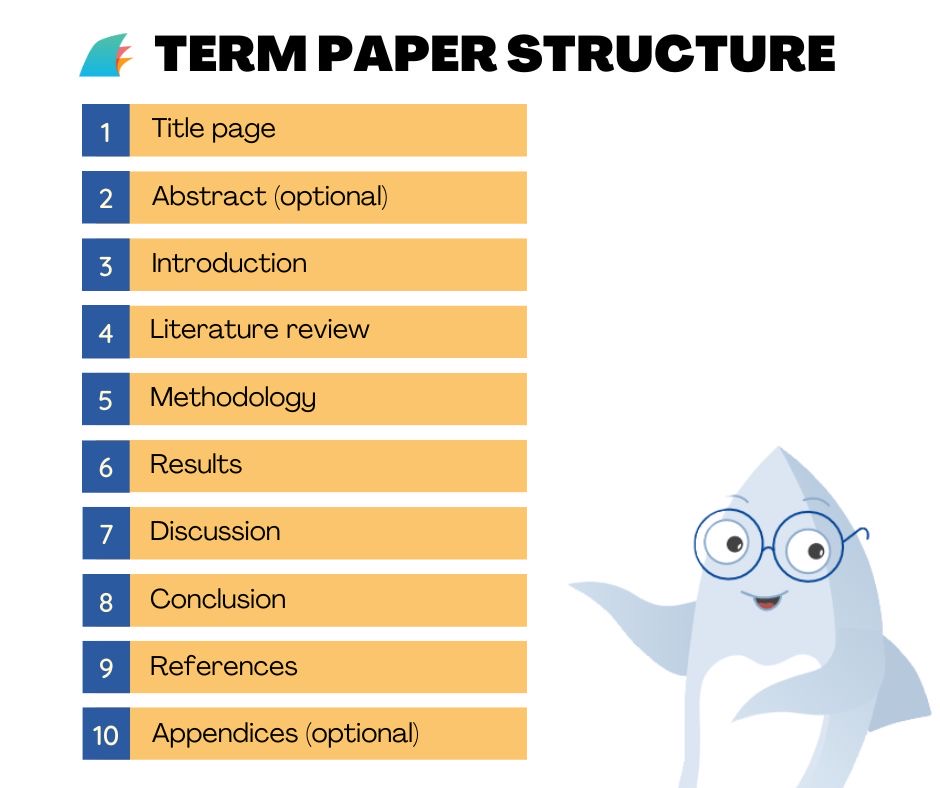
This example hits all the right paragraphs to create a well-structured term paper. Once you’ve got the basics down, it’s up to you to determine the best way to write the term paper.
Before writing a term paper
If you want to make something great, you need to prepare greatly. As the term paper is usually a longer paper than essays, you will need to make a more detailed plan before writing it.
Carefully read the assignment. To realize what the instructor wants to see from a term paper, just read the instructions attentively, like each essay writer does before writing a paper.
- Highlight the keywords. You should have already faced such assignments that begin with: analyze, comment, compare, describe, discuss, etc.
- Rewrite the requirements. It may happen that you will skip an important point when briefly skimming over the instructions. Rewrite the assignment directions in your own words and try to keep the same meaning. You can also print the requirements and place them before your eyes.
- Point out questions that should be addressed in the paper. On the basis of your assignment you can make a list of questions that should be addressed in the paper.
Conduct research. The research should be aimed at finding a distinct amount of information for the chosen topic. During this stage you need to use these skills: active reading, effective note-taking, and critical thinking.
- Find out and analyze the existing information related to the topic. While reading, always keep in mind the sole question. Consider the author’s main point and how he or she supports that point. Decide what sources you can use as a basis for your paper.
- Make notes as you read and mark the most significant information and quotes that you can use in your paper. Don’t forget to mention where you have found the information.
- Use mind-mapping, charts, diagrams, and clustering to get more ideas about the topic and gather the main points in one place.
Make an outline. On the basis of the obtained information, you can create a plan. As you can see in our “Term Paper Format” section, you can give titles to each section of your future paper. Also, we recommend you to add topic sentences to each section – this will ease the writing process.
Create a calendar. Divide the paper writing process into several steps and list them in your calendar. Term papers take more than one night to write, so make sure that you have planned enough time for it. You can make a hard copy of the timetable or save it on your computer.
How to pick sources for a term paper
Every builder knows that the foundation is the core part of the building. Without a strong foundation, the building may quickly fall to ruin. The same refers to academic writing. Without reliable sources and information, you will construct a poor paper, and will look for someone to write a term paper for cheap .
On the internet and at the library you may find tons of information related to your topic. How can you pick a reliable source? Imagine that you are Sherlock Holmes and you need to find the truth hidden in the text. You don’t need superpowers to learn how to do it.
Use your critical thinking skills while looking through each source. Let’s see what you need to pay attention to:
- Design and layout. Check whether the source looks professional.
- Date. Define whether the information is relevant.
- Author. It should be easy to find the author of the source. Think on what you know about the authors and their credentials.
- Objectivity. It should be clearly seen that the source was created for an educational or professional purpose. If you notice that the source tries to sell something, skip it.
- Writing style. If you have noticed grammar mistakes or typos, there is a high probability that the source is unreliable.
- Amount and quality of information. Look how much information is presented in the source and whether it contains graphic information, numbers, a reference list, etc. Broken links and the absence of external links may indicate a poor source.
- Suitability for your topic. Think about whether the source meets the limitations of your topic.
- Reputation. Check whether the source is non-biased. Use a fact-checking website that uses only authoritative sources.
Tip: Reading general texts from the journals and articles can help you clarify your thoughts at the beginning of your research and deciding what point you can consider on your paper.
Tip: Most search engines use the data from your web browser to sort information according to your preferences. It is also known as a “filter bubble.” Delete your browser history and cookies, and tune into the incognito mode to get another list of search results.
When you obtain a certain amount of information, you can create an extended outline. What does it mean? Take your old outline and add any new points that you have found in the sources. Think in what section you can incorporate new facts, examples, quotes, or expert opinions.
Writing the first draft of a term paper
There are many approaches to writing a term paper. The key to success is simple: be prepared before you start. Have a clear purpose, a thesis statement, enough background information, and a clear plan. If you can’t choose a good topic, use our college essay title generator to have more ideas for writing.
1. Write the abstract.
This first section should focus on what your research is about. But the best decision will be writing it after all subsequent sections. Mention major findings in your research so even a person unfamiliar with the topic can read and understand it. Keep it simple and informative.
A good abstract should consist of the following sections:
- Intro. State the issue you are addressing in your paper. Explain why the chosen topic is important. What practical, scientific, or theoretic purpose does your research have?
- Body. Highlight the major points of the research and what investigating strategy you have chosen. Describe the nature of the results.
- Conclusion. Explain how the results can be implicated.
To write an abstract, you need to reread your paper and underline the key statements related to research objectives, methods, results, and conclusions. Copy these sentences and you will receive the first draft of the abstract.
Tip: The abstract should be limited to 120-250 words (depending on assignment instructions).
What is the difference between the introduction and abstract? An abstract presents the essence of the paper: it lists the main points of the paper, including results and conclusions. The introduction provides background information on the topic, gives the proposition (or thesis statement), and outlines key issues that will be discussed in the paper.
2. Write the introduction.
Strong introductions can make it harder to put the paper down. Think about how you can “sell” your paper to the reader. What is the main point of your term paper?
- Grab attention. A good introduction starts with an interesting fact, surprising statement, contradiction, or a statement that points out the importance of the topic.
- Provide an overview. The introduction should provide a brief description of the issue and state the goal of the paper. Also, it is important to mention how this specific topic meets a broader context.
- Write the thesis statement. Tell the reader what you are arguing or what question you are addressing in your paper. Don’t announce your intentions.
The introduction should contain only general information about the paper. Its aim is to give an overview of the term paper. Examples, quotations, and excess details are not accepted.
Tip: Don’t be boring or too general. Immediately dive into the essence of the topic and draw the reader’s attention deeper into the paper.
3. Write the body sections: generating ideas and text.
Once you have received certain research results and notes, take a look at what you’ve found. Record the outcomes of your research and cut unnecessary materials.
One of the best ways to start writing body sections is drafting topic sentences referring to the outline. Write complete sentences on its basis and add supporting details.
The number of paragraphs will depend on the topic and assignment instructions. Frequently, a term paper body section consists of a literature review and the research itself.
Tip: Each paragraph should begin with a topic sentence. It should be a very clear introduction of the paragraph’s main idea.
How can you write a literary review? Present the analysis of the literature you have found on the topic. You need to present what materials you have found and how you have connected this information to the context of your research. Summarize the arguments and theories of various authors you agree with. Also, you need to highlight what points were absent or not considered in the author’s research.
Here are general recommendations while writing the body sections:
- The text should be well-structured and divided into sections or subsections. Each chapter should have a title and refer to one particular idea or main point.
- Develop arguments gradually. All your ideas should move from the general to specific.
- A good academic text needs evidence. All quotations, ideas, and data should be referenced according to the required formatting style.
- Prioritize the following points depending on your assignment instructions and objectives: analysis of primary and secondary sources, current issues and state of research, and personal point of view.
- Avoid simple summaries of existing information. Incorporate citations to prove your own point of view on the topic.
- Don’t rely on the sources only. It is your paper and it should contain your original idea about the topic. Keep the balance between the source material and your own ideas.
- Avoid writing lengthy body paragraphs. If you want to put a great amount of information into the paragraph, it would be better to divide it into subsections.
4. Write the conclusion.
When you finish writing the main part of the term paper, it’s time to summarize what information you have received and discuss the further implication of your research. Consider the following points in your conclusion:
- Refresh the points that you have already highlighted in the body paragraph and restate the thesis statement.
Note: Don’t present any new information in this paragraph.
- Describe the final results of your research.
- Explain the implication for future studies.
How can I evaluate my research results? What meaning does my research have? Does my topic intersect other topics or areas?
- Write the concluding sentence.
For example: “Forgiveness therapy is a new approach in psychology and has much need for testing, but it is an important practice in the treatment of many psychological disorders.”
Revising and polishing the first draft
If you have succeeded in writing your first draft and have some time left, it’s time to proofread your text. Don’t neglect the possibility of reading the term paper once more. Many professors perceive misspellings, as well as punctuation and grammar errors as a personal insult. These mistakes may draw more attention than your original ideas and significant results. So, how can you make your text look better?
First, you need to read your first draft and think about how you can make your paper cleaner or more convincing. Look at the ideas that don’t fit the context and remove or modify them. Then, look at what points need more detailed support. And finally, add transitional phrases or words to connect ideas. If you can’t cope with all these steps on your own, use EssayShark essay rephraser to save your nerves.
Second, when the content is logical and well-structured, it’s time to check for errors. Correct all grammar, punctuation, and spelling errors.
Last, check whether your paper has the right format and layout. Make sure that pages are numbered correctly. Images, tables, diagrams, and other visual materials also should be numbered and titled appropriately. So, check the same things you check when you finish write my essay process.
How to write a term paper in 7 steps – infographic
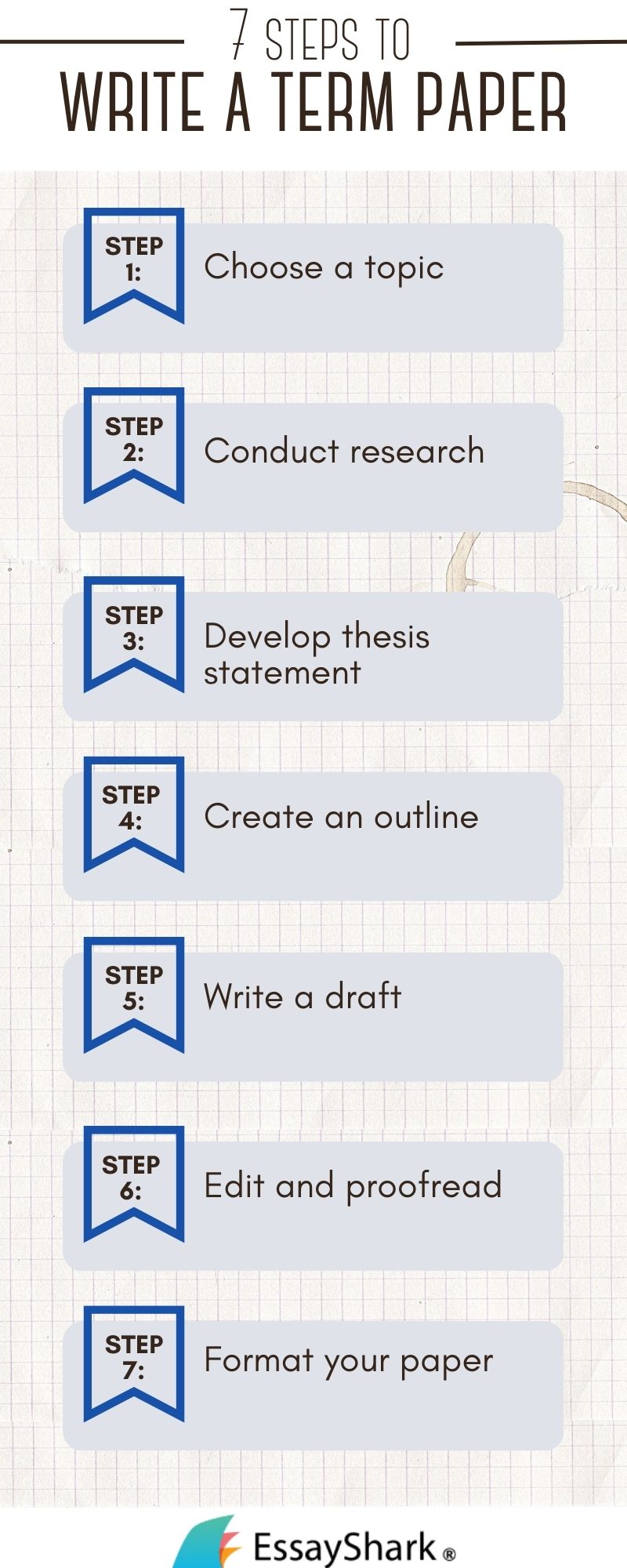
How to write a term paper in 4 hours: video guide
Mistakes to avoid in term paper writing
- Using unreliable sources. This means that all sources you have based your work on should be professional. Use newsprint, magazines, statistical data, and publications.
- Plagiarism. Whenever you are reusing someone’s ideas or incorporating expressions from other sources as your own thoughts, this is considered plagiarism. Pay attention to correct citation style and document outside sources.
- Not supporting your statements. Always back up your point of view with references or your own findings.
- Using nested sentences, repetitions, and passive voice. The text should be objective, clear, and correct.
- Choosing a topic too broad. As a result, it will be hard to meet the word limit and highlight the topic in the right way. Also, you will face the problem of having excessive amounts of information on the topic. A good term paper requires a narrow topic.
- Failing to proofread the paper. Even editing the text once may not be enough. Don’t rely on the computer’s spell check. Ask a friend or someone else to read your paper.
How to find excellent term paper topics
Paper instructions that you receive from a teacher typically provide a list of term paper topics to choose from. Luckily, sometimes students are given the freedom of choice.
First, you can start with a fairly broad idea of the area you want to research, such as “body image.” As you can see, the topic is too general and if you start googling about this topic over the internet you will get a great amount of information. You can narrow it down considering other areas:
| in terms of illustrations, advertising trends | |
| in terms of government regulation | |
| in terms of impact on health, eating habits | |
| in terms of cultural values, shopping behavior | |
| in terms of eating habits, mental disorders, behavior |
Narrowing down the topic will make your research more manageable. You can add more limitations to your research:
| Consider historic trends or analyze the current state of affairs | |
| Conducting research within a particular discipline | |
| Choose a particular country, a region, or make it worldwide | |
| Consider all genders, or only males or females | |
| Choose particular age groups (e.g. toddlers, children, adolescents, adults) or in general | |
| Only recent journal publications or overview of all existing relevant sources |
Sometimes it’s difficult to pick a topic on your own, as there are so many interesting topics to write about! We are happy to propose you a list of interesting term paper topics that you can reuse for your own paper.
- Analyze the influence of the shadow economy on the productivity of a country (your choice) from a macroeconomic perspective.
- What is the meaning of inflation/deflation/hyperinflation? Explain the causes and consequences. Support your claims with evidence.
- Define the meaning of middle class. What is the economic meaning of the middle class?
Legal Issues
- Discuss the approaches to providing censorship in social media and over the internet.
- Compare government regulation for physical desecration of national symbols in various countries.
- Discuss the meaning of mental disorder defense. What are the peculiarities?
- Is it the right idea to hide the truth from a dying patient in palliative care?
- Find out the reasons, consequences, and legal regulations of organ donation.
- Is it ethically right to test new drugs on dying patients?
- Should parents determine what the school should learn?
- Should the discipline in the school be more strict?
- Discuss streamlining in the context of the educational system of a particular country.
Tip: On our blog you can find more information on how to choose topics for term paper writing and get inspired with a list of term paper topics on technology, economics, political science, sports, media and culture, and health.
Term paper topic ideas
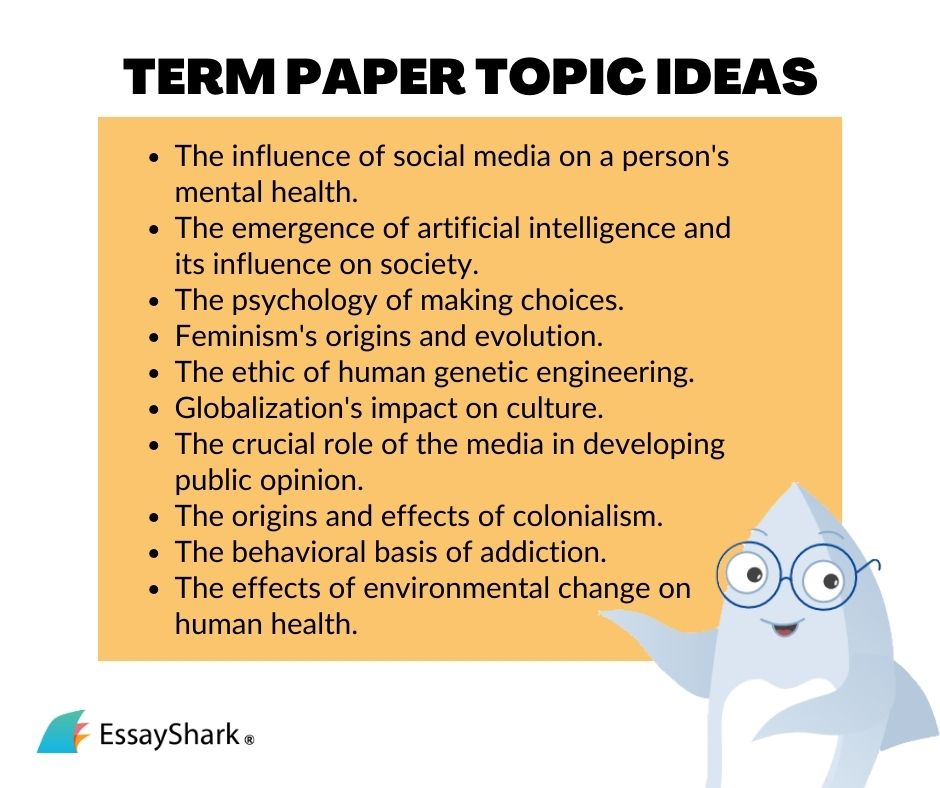
Term paper sample about healthy lifestyle promotion
In the text below you can see a portion of a term paper written by our college essay writer . It should help you understand the theoretical approaches that we have written above. Also check the comments below.
Title: The Promotion of a Healthy Lifestyle Through Social Media
This paper discusses the growing popularity of healthy lifestyles in social media. It looks into the methods of health promotion through evolving technologies. The research was built on questionnaires and existing information on the issue. The paper presents a plan for actions aimed to keep the topics about health popular over social media. (…)
Table of Contents
1. Introduction 2. Overview of Social Media 3. Plan of Action 4. Conclusion 5. References
Introduction
Social networks are some of the most popular websites over the internet. Social media use has been increasing in health promotion because it removes geographic and physical barriers. However, social media still has the potential to increase the influence of healthy lifestyles. (…)
Overview of Social Media
According to articles published in NBC Statistics, the most popular social media sites estimate more than a billion visits every day. The statistics show that more than 77 percent of people in the US have a social media profile. The majority of Americans use Facebook and Youtube on a daily basis.(…)
One of the researches has measured the change in knowledge, attitudes, behavior, eating habits, weight, energy and fat intake, self-efficacy, and sharing in social media (Hoshi, 2017). The amount of information, even in small doses, has an influence on promotion of healthy habits.
Welch et al. (2016) studied the effectiveness of health promotion campaigns in social media as Facebook, Twitter, and video sharing like YouTube. The research has shown the increased effectiveness of social media interventions in improving healthy habits among youth and older adults. (…)
Plan of Action
Social media campaigns should relate to the specific topic and plan ahead. To construct an effective campaign, we should collect the relevant information, pictures, videos, and texts.
Facebook activities. This social media platform has a wide list of events that can be used for promotion.
- Wellness events
- Health volunteers
- Sharing healthy recipes
- Tips for improving health habits
- Healthy competitions and challenges (…)
A healthy lifestyle is one of the main things that every person should apply in everyday life. To help the person make the right choice, government and organizations should spread the information about tools and advice to promote a healthy lifestyle. (…)
Hoshi, T. (2017). SES, Dietary and Lifestyle Habits, Three Health-Related Dimensions, and Healthy Survival Days. International Perspectives on Aging the Structure of Healthy Life Determinants , 121-141.
Smith, A., & Anderson, M. (2018, September 19). Social Media Use 2018: Demographics and Statistics. Pew Research Center . Retrieved from http://www.pewinternet.org/2018/03/01/social-media-use-in-2018/
Welch, V., Petkovic, J., Pardo, J. P., Rader, T., & Tugwell, P. (2016). Interactive social media interventions to promote health equity: An overview of reviews. Health Promotion and Chronic Disease Prevention in Canada: Research, Policy and Practice , 36(4), 63–75.
FAQ about term paper writing
1. what is the format of a term paper.
Speaking about the format standard for a term paper, we need to mention MLA, APA, and Chicago/Turabian as the most common format types.
In addition, students may create a specific format of term paper when it comes to its structure. The format will include several obligated elements such as title page, abstract, introduction, conclusion, and references.
2. How many pages should a good term paper be?
The standard term paper must contain at least 10-12 double-spaced pages. Term papers of 15-20 pages are also appropriate, but you must consider the quality of the content. It is always better to make the paper shorter but informative than make it longer with bland, repeated statements.
3. What is the difference between a term paper and a research paper?
The core difference between a term paper and a research paper is in the approach to sourcing. A research paper assumes a deeper investigation of a topic and analysis. When it comes to structuring, there are specific differences as well. A term paper consists of such core elements as an introduction, the main body, a conclusion, and a bibliography. A search paper includes methods, results, discussion, and other aspects of a deep analytical paper.
4. Want is the fastest way to write a term paper?
If you have a strict and short deadline, you must act quickly, skipping the outlining stage. Start with a brief brainstorm. Afterward, you will require providing research on a chosen topic. You will then have to draft a paper and quickly polish it. If you have some minutes left, read your paper to edit it or skip the proofreading stage.
5. How many citations are considered suitable for a term paper?
It depends on the discipline and the topic involved; skilled authors suggest supplementing a term paper with at least five citations, with a maximum of ten.
Term paper writing help from industry experts
Want more term paper examples? Check out our EssayShark blog. If you compare our examples, you will see that they all share three qualities: they are interesting to read, they have good grammar and style, and contain in-text references to reliable sources.
We know how writing a term paper can be a struggle. A lack of time, missed deadlines, a sudden flu, tons of homework, and other troubles may spoil even the most accurate writing plan. There is no need to get discouraged while you have a trusted term paper writing service at hand.
Even if you have never tried such services, you need to know that it’s the ultimate solution for students who need urgent help with their assignments. EssayShark experts can help you with term papers for any course, discipline, and school. Also, our experts can help you pick the right topic for the term paper, write missing paragraphs for existing parts of the paper, and edit your first draft.
Get a unique and polished term paper help before the deadline and live your life to the fullest!

2 thoughts on “ A Quick-Start Guide on How to Write a Term Paper ”
I have got good ideas for my first term paper preparation. Thank you so much.
like this term paper writing guide
Leave a Reply Cancel reply
Your email address will not be published. Required fields are marked *
Save my name, email, and website in this browser for the next time I comment.
What our customers say
Our website uses secure cookies. More details
Get professional help from best writers right from your phone

Grab our 3 e-books bundle for $27 FREE
How To Write a Term Paper: A Guide That Works
30 June, 2020
16 minutes read
Author: Mathieu Johnson
Once you’ve started your university career, you are going to be asked to present a term paper. What’s the difference between a term paper and a research paper? How can you write a good term? What’s the best way to structure it? Where can you find some tips to make the writing process faster? In this article, we’ll discuss a few tips to help you prepare a term paper quickly and professionally.

What Is a Term Paper… And What Is The First Step?
A term paper is a critical and analytical report on the topic or subject that you covered within the course of studies. It usually consists of two separate but equally important aspects: your own thoughts about the topic and a demonstration of your understanding of the existing literature. The main goal of this assignment is to summarize the material you learned and showcase your understanding of the topic. This aspect makes the term paper a universal instrument for assessing a student’s proficiency. It also explains why term papers cost so many points of your course grade.
We usually associate a term paper with a research paper , but although the concepts are quite similar, a research paper requires a more academic approach and a deeper investigation into the literature of your field of study.
To write an outstanding college term paper, you must understand that your professor has requested it in order to test your analytical thinking skills. You must collect relevant data, analyze it, and then make a summary or solve a particular problem. Such skills are highly relevant to the business world, so this type of the task is as practical as it is educational.
So, let’s start the preparation!

Before you begin writing

Unfortunately, there is no magical recipe that allows you to get everything done fast. You will need to choose the best way forward in whatever situation you find yourself, but here are some tips to help you prepare for the assignment.
To begin with, take the research stage seriously . Sometimes, when students are really interested in a topic, they only want to present their personal ideas about the problem. Unfortunately, if you’re not completely familiar with all the data from the various sources, you will need to reinvent the bicycle.
Term paper writing was never an easy ride. Well, not for our expert writers. Place an order with our term paper writing service and secure yourself an “A!”
In the initial stages of your research, investigate everything you can find on the topic . This may sound like a tall order, but you’ll find that it doesn’t actually entail that much reading. At this point you are only compiling the research, so you will be skimming through numerous prospects rather than reading them completely. Bear in mind that your aim is to get acquainted with the various aspects of your problem. The term paper summarizes the knowledge you gained within a course and requires to familiarize yourself with the research that other people have already made on your topic.
Thinking that your opinions are completely original and unique is quite egocentric, and it can get you into trouble. So, “your” thoughts about the problem are usually just somebody else’s statements that you have rephrased (or even a well-established academic concept!). Remember that your professor will be familiar with all the literature surrounding the issue: if you merely rewrite someone else’s thoughts and present them as your own (even if you don’t realize doing it), be prepared for criticism!
Applying a Structure To Your Term Paper

Once you have read all the leading authors and their approaches to your problem, it’s time to create a structure for your work. This is not yet an outline; you just need to decide what to write about. Sketch out the topic for the theoretical portion of your work and think about practical aspects and how you can approach the research in the best possible way.
At this point, you really need to call or email your supervisor . Your professor will have seen hundreds of term papers like yours (i.e., they have not yet been written, but a definite idea exists!) and will be prepared to give you feedback and advice. He or she will tell you what literature you have omitted, offer suggestions about what you should read, and give you feedback about your paper. It may well be that your approach has already occurred to somebody else, in which case there is no need to repeat it.
Choosing a Topic: Easy as Riding a Bike?
When you choose your topic, make sure you choose something that you are interested in . That’s our advice if you want a painless term paper. If you prefer to investigate a field that you’ve never really explored before, you can challenge yourself to do that, too. That might be sophisticated, but why not?
If you decide to investigate a topic or a problem that you are pretty familiar with, your writing will be more fluid. You will focus your attention on a specific aspect of the chosen field and expand your knowledge within that scope. On the contrary, choosing an unfamiliar subject matter can wash out your expertise.
Be prepared to change the topic if you find out that your research isn’t going anywhere. It might occur that you presuppose that your topic has a potential but somewhere at the stage of initial research, you find that it just won’t work. It’s always a good idea to consider two or three topics when you kick off the term paper writing – even if they are just different ways of examining the same problem. By doing this, you will be able to choose the best version, which may not be the one you started with at all!
Related Post: 100 Persuasive essay topics
Formulating a Thesis statement

Writing a proper thesis statement can also be challenging. To begin with, write down a couple of prominent ideas or concepts, then try to make rough drafts of them to see how they’ll work in the structural framework. You will probably find that one idea fits your style, interests, and knowledge base: you can choose that one as your thesis statement.
Remember that the thesis statement is the skeleton, the central concept of your paper. It is the elemental attribute of almost any academic paper – from master’s thesis to a simple five paragraph essay. If you do a thorough job on it, you will find that writing (and defending!) your argument is much easier.
Be aware that all of these stages are parts of a procedure – one leads to another. When writing a term paper, you should collect the material and wrap it up at the same time.
Planning – The Key To Success
Some people claim that they can write a term paper without any planning. In our opinion, this is impossible. If you don’t have a postgraduate degree and you aren’t a certified genius, you need to prepare an outline for your project. It may come as a surprise, but even people who claim otherwise actually prepare outlines – in their heads. But if you don’t have that much experience, use a pencil and your notebook to ensure that you don’t forget anything.
Don’t procrastinate on your College or University papers anymore. Get professional help with our essay writer !
That’s when we get to preparing your first draft . There’s only one thing to add here: do as many drafts as you need in order to achieve your goal. Understand that your aim is to create an excellent term paper and keep working at it until you are satisfied.
Term Paper Outline: Write Everything In The Proper Section!

In the Introduction , state the topic that you are going to investigate and the context of your work. This is the critical ‘selling’ moment of your work. In a nutshell, your introduction combined with a conclusion should give a sneak peek into what the whole paper is about. If your introduction is well-prepared, it will be quite complacent about the body of your project. The introduction must include an abstract that presents your thesis statement . You should explain your motivation (why should the reader be concerned about this problem?) , your methods (what scientific tools did you use?) , and the results (what you achieved) .
The Literature Review totally corresponds to its name – it is here to review the literature you compiled. Your professor will double check it to make sure that you understand the context of your argument. One more thing to add is: collect all the information you can! Ideally, you should read or at least glance through every book and author that you can find on the topic. Think of your task as a fascinating journey: if you approach it like that, reading hundreds of pages won’t seem like that much of a challenge.
In the Discussion , you must present the interpretations of the problem. Be honest, explain what you pieces of data you don’t agree with and what ideas and concepts you support. This section connects the dots between theory and practice when writing a term paper. Wherever possible, provide several interpretations of the subject matter, then choose the one(s) that are most relevant to the case you are presenting.
In the Body , focus on those arguments that prove your thesis statement. This section must be absolutely logical. If you have chosen a more complicated topic, use heading and sub-headings to improve the appearance of this section. While writing the body, keep your target audience (your professors) in mind. In other words, don’t just record the obvious causes/effects/solutions but also showcase your own findings – what you have discovered and how that proves your thesis statement. Demonstrate that you are familiar with the details and you will stun your readers with the prolific mastery of the topic.
Now, the Conclusion is her to summarize both the content and the purpose of the paper. The most challenging part is not to make it too dry. Reiterate your thesis statement and briefly show how your results justified your proposition. At the very end, you can suggest a call to action or pose a rhetorical question or statement that leaves your reader wanting more.
What to do next?
When you have finished, reread your work a couple of times. You will almost certainly find a few faults, whether they are contextual, factual, syntactical, grammatical, or even simple spelling mistakes. A very useful tip is to wait for two or three days after writing your final draft to proofread it afterward. Your brain will have time to process the information, and you’ll be able to look at it with a fresh view.

When proofreading, take care to polish the structural problems. The skeleton (the logic and the thesis statement) should make sense. If they don’t, try to approach the problem from another perspective. The changes may take some time, but bear in mind that your objective is to produce professional work. Be patient!
After that, print the term paper. The human eye processes information differently on the paper than on a computer screen; that’s why you need to print it and take one final look for any possible mistakes. Even if you don’t see any serious defects, pay attention to formatting, punctuation, and synonyms. It’s an academic text, so make it shine!
Term Paper Sample
Be sure to check the sample of a term paper, completed by our writers. Use it as an example to perfect your own writing. Link: Term Paper Sample: Consumer Buying Behavior .
The Do’s and Don’ts of Term Paper Writing
| . It’s a handy tool for finding quotes from notable works. | knowledge, too. |
There you have the most important tips to help you succeed in writing a term paper. Now it’s up to you to stop reading and start writing!

A life lesson in Romeo and Juliet taught by death
Due to human nature, we draw conclusions only when life gives us a lesson since the experience of others is not so effective and powerful. Therefore, when analyzing and sorting out common problems we face, we may trace a parallel with well-known book characters or real historical figures. Moreover, we often compare our situations with […]

Ethical Research Paper Topics
Writing a research paper on ethics is not an easy task, especially if you do not possess excellent writing skills and do not like to contemplate controversial questions. But an ethics course is obligatory in all higher education institutions, and students have to look for a way out and be creative. When you find an […]

Art Research Paper Topics
Students obtaining degrees in fine art and art & design programs most commonly need to write a paper on art topics. However, this subject is becoming more popular in educational institutions for expanding students’ horizons. Thus, both groups of receivers of education: those who are into arts and those who only get acquainted with art […]

How to Write a Term Paper From Start to Finish

The term paper, often regarded as the culmination of a semester's hard work, is a rite of passage for students in pursuit of higher education. Here's an interesting fact to kick things off: Did you know that the term paper's origins can be traced back to ancient Greece, where scholars like Plato and Aristotle utilized written works to explore and document their philosophical musings? Just as these great minds once wrote their thoughts on parchment, you, too, can embark on this intellectual voyage with confidence and skill.
How to Write a Term Paper: Short Description
In this article, we'll delve into the core purpose of this kind of assignment – to showcase your understanding of a subject, your research abilities, and your capacity to communicate complex ideas effectively. But it doesn't stop there. We'll also guide you in the art of creating a well-structured term paper format, a roadmap that will not only keep you on track but also ensure your ideas flow seamlessly and logically. Packed with valuable tips on writing, organization, and time management, this resource promises to equip you with the tools needed to excel in your academic writing.
Understanding What Is a Term Paper
A term paper, a crucial component of your college education, is often assigned towards the conclusion of a semester. It's a vehicle through which educators gauge your comprehension of the course content. Imagine it as a bridge between what you've learned in class and your ability to apply that knowledge to real-world topics.
For instance, in a history course, you might be asked to delve into the causes and consequences of a significant historical event, such as World War II. In a psychology class, your term paper might explore the effects of stress on mental health, or in an environmental science course, you could analyze the impact of climate change on a specific region.
Writing a term paper isn't just about summarizing facts. It requires a blend of organization, deep research, and the art of presenting your findings in a way that's both clear and analytical. This means structuring your arguments logically, citing relevant sources, and critically evaluating the information you've gathered.
For further guidance, we've prepared an insightful guide for you authored by our expert essay writer . It's brimming with practical tips and valuable insights to help you stand out in this academic endeavor and earn the recognition you deserve.
How to Start a Term Paper
Before you start, keep the guidelines for the term paper format firmly in mind. If you have any doubts, don't hesitate to reach out to your instructor for clarification before you begin your research and writing process. And remember, procrastination is your worst enemy in this endeavor. If you're aiming to produce an exceptional piece and secure a top grade, it's essential to plan ahead and allocate dedicated time each day to work on it. Now, let our term paper writing services provide you with some valuable tips to help you on your journey:

- Hone Your Topic : Start by cultivating a learning mindset that empowers you to effectively organize your thoughts. Discover how to research a topic in the section below.
- Hook Your Readers: Initiate a brainstorming session and unleash a barrage of creative ideas to captivate your audience right from the outset. Pose intriguing questions, share compelling anecdotes, offer persuasive statistics, and more.
- Craft a Concise Thesis Statement Example : If you find yourself struggling to encapsulate the main idea of your paper in just a sentence or two, it's time to revisit your initial topic and consider narrowing it down.
- Understand Style Requirements: Your work must adhere to specific formatting guidelines. Delve into details about the APA format and other pertinent regulations in the section provided.
- Delve Deeper with Research : Equipped with a clearer understanding of your objectives, dive into your subject matter with a discerning eye. Ensure that you draw from reputable and reliable sources.
- Begin Writing: Don't obsess over perfection from the get-go. Just start writing, and don't worry about initial imperfections. You can always revise or remove those early sentences later. The key is to initiate the term papers as soon as you've amassed sufficient information.
Ace your term paper with EssayPro 's expert help. Our academic professionals are here to guide you through every step, ensuring your term paper is well-researched, structured, and written to the highest standards.

Term Paper Topics
Selecting the right topic for your term paper is a critical step, one that can significantly impact your overall experience and the quality of your work. While instructors sometimes provide specific topics, there are instances when you have the freedom to choose your own. To guide you on how to write a term paper, consider the following factors when deciding on your dissertation topics :

- Relevance to Assignment Length: Begin by considering the required length of your paper. Whether it's a substantial 10-page paper or a more concise 5-page one, understanding the word count will help you determine the appropriate scope for your subject. This will inform whether your topic should be broad or more narrowly focused.
- Availability of Resources : Investigate the resources at your disposal. Check your school or community library for books and materials that can support your research. Additionally, explore online sources to ensure you have access to a variety of reference materials.
- Complexity and Clarity : Ensure you can effectively explain your chosen topic, regardless of how complex it may seem. If you encounter areas that are challenging to grasp fully, don't hesitate to seek guidance from experts or your professor. Clarity and understanding are key to producing a well-structured term paper.
- Avoiding Overused Concepts : Refrain from choosing overly trendy or overused topics. Mainstream subjects often fail to captivate the interest of your readers or instructors, as they can lead to repetitive content. Instead, opt for a unique angle or approach that adds depth to your paper.
- Manageability and Passion : While passion can drive your choice of topic, it's important to ensure that it is manageable within the given time frame and with the available resources. If necessary, consider scaling down a topic that remains intriguing and motivating to you, ensuring it aligns with your course objectives and personal interests.
Worrying About the Quality of Your Upcoming Essay?
"Being highly trained professionals, our writers can provide term paper help by creating a paper specifically tailored to your needs.
Term Paper Outline
Before embarking on the journey of writing a term paper, it's crucial to establish a well-structured outline. Be mindful of any specific formatting requirements your teacher may have in mind, as these will guide your outline's structure. Here's a basic format to help you get started:
- Cover Page: Begin with a cover page featuring your name, course number, teacher's name, and the deadline date, centered at the top.
- Abstract: Craft a concise summary of your work that informs readers about your paper's topic, its significance, and the key points you'll explore.
- Introduction: Commence your term paper introduction with a clear and compelling statement of your chosen topic. Explain why it's relevant and outline your approach to addressing it.
- Body: This section serves as the meat of academic papers, where you present the primary findings from your research. Provide detailed information about the topic to enhance the reader's understanding. Ensure you incorporate various viewpoints on the issue and conduct a thorough analysis of your research.
- Results: Share the insights and conclusions that your research has led you to. Discuss any shifts in your perspective or understanding that have occurred during the course of your project.
- Discussion: Conclude your term paper with a comprehensive summary of the topic and your findings. You can wrap up with a thought-provoking question or encourage readers to explore the subject further through their own research.
How to Write a Term Paper with 5 Steps
Before you begin your term paper, it's crucial to understand what a term paper proposal entails. This proposal serves as your way to introduce and justify your chosen topic to your instructor, and it must gain approval before you start writing the actual paper.
In your proposal, include recent studies or research related to your topic, along with proper references. Clearly explain the topic's relevance to your course, outline your objectives, and organize your ideas effectively. This helps your instructor grasp your term paper's direction. If needed, you can also seek assistance from our expert writers and buy term paper .

Draft the Abstract
The abstract is a critical element while writing a term paper, and it plays a crucial role in piquing the reader's interest. To create a captivating abstract, consider these key points from our dissertation writing service :
- Conciseness: Keep it short and to the point, around 150-250 words. No need for lengthy explanations.
- Highlight Key Elements: Summarize the problem you're addressing, your research methods, and primary findings or conclusions. For instance, if your paper discusses the impact of social media on mental health, mention your research methods and significant findings.
- Engagement: Make your abstract engaging. Use language that draws readers in. For example, if your paper explores the effects of artificial intelligence on the job market, you might begin with a question like, 'Is AI revolutionizing our work landscape, or should we prepare for the robots to take over?'
- Clarity: Avoid excessive jargon or technical terms to ensure accessibility to a wider audience.
Craft the Introduction
The introduction sets the stage for your entire term paper and should engage readers from the outset. To craft an intriguing introduction, consider these tips:
- Hook Your Audience: Start with a captivating hook, such as a thought-provoking question or a compelling statistic. For example, if your paper explores the impact of smartphone addiction, you could begin with, 'Can you remember the last time you went a whole day without checking your phone?'
- State Your Purpose: Clearly state the purpose of your paper and its relevance. If your term paper is about renewable energy's role in combating climate change, explain why this topic is essential in today's world.
- Provide a Roadmap: Briefly outline how your paper is structured. For instance, if your paper discusses the benefits of mindfulness meditation, mention that you will explore its effects on stress reduction, emotional well-being, and cognitive performance.
- Thesis Statement: Conclude your introduction with a concise thesis statement that encapsulates the central argument or message of your paper. In the case of a term paper on the impact of online education, your thesis might be: 'Online education is revolutionizing learning by providing accessibility, flexibility, and innovative teaching methods.'
Develop the Body Sections: Brainstorming Concepts and Content
Generate ideas and compose text: body sections.
The body of your term paper is where you present your research, arguments, and analysis. To generate ideas and write engaging text in the body sections, consider these strategies from our research paper writer :
- Structure Your Ideas: Organize your paper into sections or paragraphs, each addressing a specific aspect of your topic. For example, if your term paper explores the impact of social media on interpersonal relationships, you might have sections on communication patterns, privacy concerns, and emotional well-being.
- Support with Evidence: Back up your arguments with credible evidence, such as data, research findings, or expert opinions. For instance, when discussing the effects of social media on mental health, you can include statistics on social media usage and its correlation with anxiety or depression.
- Offer Diverse Perspectives: Acknowledge and explore various viewpoints on the topic. When writing about the pros and cons of genetic engineering, present both the potential benefits, like disease prevention, and the ethical concerns associated with altering human genetics.
- Use Engaging Examples: Incorporate real-life examples to illustrate your points. If your paper discusses the consequences of climate change, share specific instances of extreme weather events or environmental degradation to make the topic relatable.
- Ask Thought-Provoking Questions: Integrate questions throughout your text to engage readers and stimulate critical thinking. In a term paper on the future of artificial intelligence, you might ask, 'How will AI impact job markets and the concept of work in the coming years?'
Formulate the Conclusion
The conclusion section should provide a satisfying wrap-up of your arguments and insights. To craft a compelling term paper example conclusion, follow these steps:
- Revisit Your Thesis: Begin by restating your thesis statement. This reinforces the central message of your paper. For example, if your thesis is about the importance of biodiversity conservation, reiterate that biodiversity is crucial for ecological balance and human well-being.
- Summarize Key Points: Briefly recap the main points you've discussed in the body of your paper. For instance, if you've been exploring the impact of globalization on local economies, summarize the effects on industries, job markets, and cultural diversity.
- Emphasize Your Main Argument: Reaffirm the significance of your thesis and the overall message of your paper. Discuss why your findings are important or relevant in a broader context. If your term paper discusses the advantages of renewable energy, underscore its potential to combat climate change and reduce our reliance on fossil fuels.
- Offer a Thoughtful Reflection: Share your own reflections or insights about the topic. How has your understanding evolved during your research? Have you uncovered any unexpected findings or implications? If your paper discusses the future of space exploration, consider what it means for humanity's quest to explore the cosmos.
- End with Impact: Conclude your term paper with a powerful closing statement. You can leave the reader with a thought-provoking question, a call to action, or a reflection on the broader implications of your topic. For instance, if your paper is about the ethics of artificial intelligence, you could finish by asking, 'As AI continues to advance, what ethical considerations will guide our choices and decisions?'
Edit and Enhance the Initial Draft
After completing your initial draft, the revision and polishing phase is essential for improving your paper. Here's how to refine your work efficiently:
- Take a Break: Step back and return to your paper with a fresh perspective.
- Structure Check: Ensure your paper flows logically and transitions smoothly from the introduction to the conclusion.
- Clarity and Conciseness: Trim excess words for clarity and precision.
- Grammar and Style: Proofread for errors and ensure consistent style.
- Citations and References: Double-check your citations and reference list.
- Peer Review: Seek feedback from peers or professors for valuable insights.
- Enhance Intro and Conclusion: Make your introduction and conclusion engaging and impactful.
- Coherence Check: Ensure your arguments support your thesis consistently.
- Read Aloud: Reading your paper aloud helps identify issues.
- Final Proofread: Perform a thorough proofread to catch any remaining errors.
Term Paper Format
When formatting your term paper, consider its length and the required citation style, which depends on your research topic. Proper referencing is crucial to avoid plagiarism in academic writing. Common citation styles include APA and MLA.
If unsure how to cite term paper for social sciences, use the APA format, including the author's name, book title, publication year, publisher, and location when citing a book.
For liberal arts and humanities, MLA is common, requiring the publication name, date, and location for referencing.
Adhering to the appropriate term paper format and citation style ensures an organized and academically sound paper. Follow your instructor's guidelines for a polished and successful paper.
Term Paper Example
To access our term paper example, simply click the button below.
The timeline of events from 1776 to 1861, that, in the end, prompted the American Civil War, describes and relates to a number of subjects modern historians acknowledge as the origins and causes of the Civil War. In fact, pre-Civil War events had both long-term and short-term influences on the War—such as the election of Abraham Lincoln as the American president in 1860 that led to the Fall of Fort Sumter in April of the same year. In that period, contentions that surrounded states’ rights progressively exploded in Congress—since they were the initial events that formed after independence. Congress focused on resolving significant issues that affected the states, which led to further issues. In that order, the US’s history from 1776 to 1861 provides a rich history, as politicians brought forth dissimilarities, dissections, and tensions between the Southern US & the people of slave states, and the Northern states that were loyal to the Union. The events that unfolded from the period of 1776 to 1861 involved a series of issues because they promoted the great sectional crisis that led to political divisions and the build-up to the Civil War that made the North and the South seem like distinctive and timeless regions that predated the crisis itself.
Final Thoughts
In closing, approach the task of writing term papers with determination and a positive outlook. Begin well in advance, maintain organization, and have faith in your capabilities. Don't hesitate to seek assistance if required, and express your individual perspective with confidence. You're more than capable of succeeding in this endeavor!
Need a Winning Hand in Academia?
Arm yourself with our custom-crafted academic papers that are sharper than a well-honed pencil! Order now and conquer your academic challenges with style!
What is the Difference between a Term Paper and a Research Paper?
What is the fastest way to write a term paper.

Daniel Parker
is a seasoned educational writer focusing on scholarship guidance, research papers, and various forms of academic essays including reflective and narrative essays. His expertise also extends to detailed case studies. A scholar with a background in English Literature and Education, Daniel’s work on EssayPro blog aims to support students in achieving academic excellence and securing scholarships. His hobbies include reading classic literature and participating in academic forums.

is an expert in nursing and healthcare, with a strong background in history, law, and literature. Holding advanced degrees in nursing and public health, his analytical approach and comprehensive knowledge help students navigate complex topics. On EssayPro blog, Adam provides insightful articles on everything from historical analysis to the intricacies of healthcare policies. In his downtime, he enjoys historical documentaries and volunteering at local clinics.
Related Articles
.webp)
- PRO Courses Guides New Tech Help Pro Expert Videos About wikiHow Pro Upgrade Sign In
- EDIT Edit this Article
- EXPLORE Tech Help Pro About Us Random Article Quizzes Request a New Article Community Dashboard This Or That Game Popular Categories Arts and Entertainment Artwork Books Movies Computers and Electronics Computers Phone Skills Technology Hacks Health Men's Health Mental Health Women's Health Relationships Dating Love Relationship Issues Hobbies and Crafts Crafts Drawing Games Education & Communication Communication Skills Personal Development Studying Personal Care and Style Fashion Hair Care Personal Hygiene Youth Personal Care School Stuff Dating All Categories Arts and Entertainment Finance and Business Home and Garden Relationship Quizzes Cars & Other Vehicles Food and Entertaining Personal Care and Style Sports and Fitness Computers and Electronics Health Pets and Animals Travel Education & Communication Hobbies and Crafts Philosophy and Religion Work World Family Life Holidays and Traditions Relationships Youth
- Browse Articles
- Learn Something New
- Quizzes Hot
- This Or That Game
- Train Your Brain
- Explore More
- Support wikiHow
- About wikiHow
- Log in / Sign up
- Education and Communications
- Presentations
How to Prepare a Paper Presentation
Last Updated: October 4, 2023 Fact Checked
This article was co-authored by Patrick Muñoz . Patrick is an internationally recognized Voice & Speech Coach, focusing on public speaking, vocal power, accent and dialects, accent reduction, voiceover, acting and speech therapy. He has worked with clients such as Penelope Cruz, Eva Longoria, and Roselyn Sanchez. He was voted LA's Favorite Voice and Dialect Coach by BACKSTAGE, is the voice and speech coach for Disney and Turner Classic Movies, and is a member of Voice and Speech Trainers Association. There are 9 references cited in this article, which can be found at the bottom of the page. This article has been fact-checked, ensuring the accuracy of any cited facts and confirming the authority of its sources. This article has been viewed 364,057 times.
A paper is bad enough, but presentations are even more nerve-wracking. You've got the writing down, but how do you turn it into a dynamic, informative, enjoyable presentation? Why, here's how!
Guidelines and Audience

- Know how long the speech must be.
- Know how many points you're required to cover.
- Know if you must include sources or visuals.

- If you're presenting to people you know, it'll be easy to know what to break down and what to gloss over. But if you're presenting to unknown stockholders or faculty, for instance, you need to know about them and their knowledge levels, too. You may have to break your paper down into its most basic concepts. Find out what you can about their backgrounds.

- Does the facility have a computer and projector screen?
- Is there a working WiFi connection?
- Is there a microphone? A podium?
- Is there someone who can assist you in working the equipment before your presentation?
Script and Visuals

- Only have one point per notecard -- that way you won't end up searching the notecard for your information. And don't forget to number the cards in case you get mixed up! And the points on your cards shouldn't match your paper; instead of regurgitating information, discuss why the key points of your paper are important or the different points of view on this topic within the field.

- As you go through this outline, remove any jargon if it may not be understood.

- If you won't have access to the proper technology, print visual aids on poster board or foam-core board.
- If using presentation software, use words sparingly, but enough to get your point across. Think in phrases (and pictures!), not sentences. Acronyms and abbreviations are okay on the screen, but when you talk, address them fully. And remember to use large fonts -- not everyone's vision is fantastic. [7] X Research source

- It's okay to be a bit repetitive. Emphasizing important ideas will enhance comprehension and recall. When you've gone full circle, cycle back to a previous point to lead your audience to the right conclusion.
- Minimize the unnecessary details (the procedure you had to go through, etc.) when highlighting the main ideas you want to relay. You don't want to overload your audience with fluff, forcing them to miss the important stuff.
- Show enthusiasm! A very boring topic can be made interesting if there is passion behind it.
Practice, Practice, and More Practice

- If you can grab a friend who you think has a similar knowledge level to your audience, all the better. They'll help you see what points are foggier to minds with less expertise on the topic.

- It'll also help you with volume. Some people get rather timid when in the spotlight. You may not be aware that you're not loud enough!

- Do the same with your conclusion. Thank everyone for their time and open the floor for any questions, if allowed.
- Make eye contact with people in the audience to help build your connection with them.
What Is The Best Way To Start a Presentation?
Community Q&A
- Most people get nervous while public speaking. [10] X Research source You are not alone. [11] X Trustworthy Source Mayo Clinic Educational website from one of the world's leading hospitals Go to source Thanks Helpful 0 Not Helpful 1
- Visual aids not only help the audience, but they can help jog your memory if you forget where you are in your presentation. Thanks Helpful 0 Not Helpful 0
- Rehearse in front of a mirror before your presentation. Thanks Helpful 0 Not Helpful 0

- Answer questions only if it is related to your presentation. Keep these to the end of your talk. Thanks Helpful 76 Not Helpful 14
You Might Also Like

- ↑ https://theihs.org/blog/prepare-for-a-paper-presentation-at-an-academic-conference/
- ↑ https://writingcenter.unc.edu/conference-papers/
- ↑ https://www.ncsl.org/legislators-staff/legislative-staff/legislative-staff-coordinating-committee/tips-for-making-effective-powerpoint-presentations.aspx
- ↑ https://www.youtube.com/watch?v=4qZMPW5g-v8
- ↑ https://twp.duke.edu/sites/twp.duke.edu/files/file-attachments/paper-to-talk.original.pdf
- ↑ http://www.cs.swarthmore.edu/~newhall/presentation.html
- ↑ https://www.forbes.com/sites/georgebradt/2014/09/10/big-presentation-dont-do-it-have-a-conversation-instead/#6d56a3f23c4b
- ↑ https://www.psychologytoday.com/us/blog/smashing-the-brainblocks/201711/why-are-we-scared-public-speaking
- ↑ https://www.mayoclinic.org/diseases-conditions/specific-phobias/expert-answers/fear-of-public-speaking/faq-20058416
About This Article

To prepare a paper presentation, create an outline of your content, then write your script on note cards or slides using software like PowerPoint. Be sure to stick to one main point per card or slide! Next, design visual aids like graphics, charts, and bullet points to illustrate your content and help the audience follow along. Then, practice giving your presentation in front of friends and family until you feel ready to do it in class! For tips on creating an outline and organizing your information, read on! Did this summary help you? Yes No
- Send fan mail to authors
Reader Success Stories
Vignesh Sanjeevi
Mar 8, 2016
Did this article help you?
Pulicheri Gunasri
Mahesh Prajapati
Sep 14, 2017
Geraldine Jean Michel
Oct 25, 2016

Featured Articles

Trending Articles

Watch Articles

- Terms of Use
- Privacy Policy
- Do Not Sell or Share My Info
- Not Selling Info
wikiHow Tech Help Pro:
Develop the tech skills you need for work and life
Purdue Online Writing Lab Purdue OWL® College of Liberal Arts
Welcome to the Purdue Online Writing Lab

Welcome to the Purdue OWL
This page is brought to you by the OWL at Purdue University. When printing this page, you must include the entire legal notice.
Copyright ©1995-2018 by The Writing Lab & The OWL at Purdue and Purdue University. All rights reserved. This material may not be published, reproduced, broadcast, rewritten, or redistributed without permission. Use of this site constitutes acceptance of our terms and conditions of fair use.
The Online Writing Lab (the Purdue OWL) at Purdue University houses writing resources and instructional material, and we provide these as a free service at Purdue. Students, members of the community, and users worldwide will find information to assist with many writing projects. Teachers and trainers may use this material for in-class and out-of-class instruction.
The On-Campus and Online versions of Purdue OWL assist clients in their development as writers—no matter what their skill level—with on-campus consultations, online participation, and community engagement. The Purdue OWL serves the Purdue West Lafayette and Indianapolis campuses and coordinates with local literacy initiatives. The Purdue OWL offers global support through online reference materials and services.
Social Media
Facebook twitter.
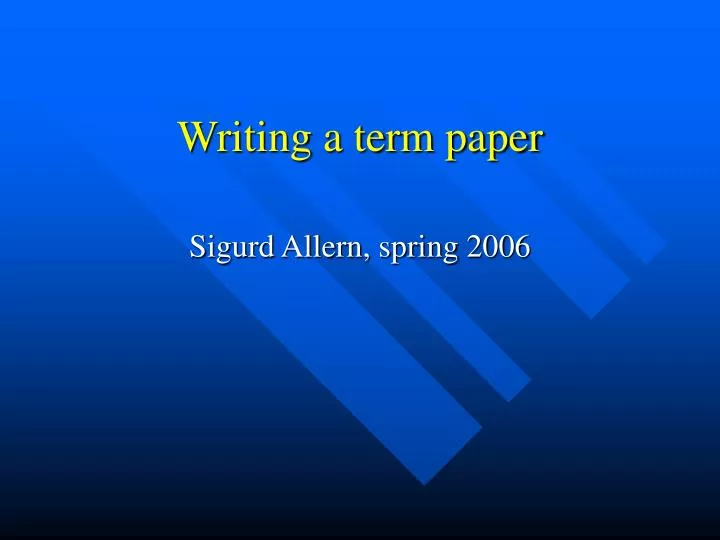
Writing a term paper
Oct 09, 2014
110 likes | 295 Views
Writing a term paper. Sigurd Allern, spring 2006. The Five Paragraph Essay. 1) Introducing the reader to the topic. Make it clear and limited. Present your thesis and subtopics.
Share Presentation
- information
- reference list
- special rules
- separate reference list
- slik ble protestene iscenesatt

Presentation Transcript
Writing a term paper Sigurd Allern, spring 2006
The Five Paragraph Essay • 1) Introducing the reader to the topic. Make it clear and limited. Present your thesis and subtopics. • 2-4: Restatements of the three supporting ideas presented in the first paragraph. Each of these is again supported by supporting sentences. Present your empirical evidence. • 5: The summary paragraph: the last chance to convince the reader of the validity of the information presented.
Sources • Part of what you write will be based on other authors ideas, theories, arguments and data. • Show where you have gout your inspiration and information through references. • References secure that the reader can identify your sources – and your own independent contribution. • Lacking or inadequate references can lead to suspicions and accusations of plagiarism.
Plagiarism • Plagiarism is to present other authors work as your own. • Plagiarism is regarded as cheating
References • Name your source when you are quoting fro another text • Name your source when you are paraphrasing; expressing in a shorter or different way what someone has said or written • Name your source when you refer to something • It is NOT necessary to name your source if you refer to something that is generally known and accepted (like: George W. Bush was re-elected president in the US..)
Choose a reference system • The Harvard system: based on author and year (give the authors name and year in the text, and all information about the book/article in alphabetic order in a separate reference list. • The Vancouver system: a number system. In the text give up a (serial) number, in the reference give the full information in the same order.
Harvard style, special rules • If a source has more than two authors, just refer to the first name and then write: & al. • Several publications from one author from the same year are separated by a, b, c after the publication year • If you use secondary sources name your your source and refer to the quotation for the secondary source
Harvard, special rules (2) • Quotations under two lines of written words can be quoted directly in your own text. • If you are quoting more than two lines of written words you can use the tab key to indent the quotation: Xxxxxxxxxxxx Xxxxxxxxxxxxxx xxxxxxxxxxxxxx
Reference list (example) • Bjørklund, Tor (1991). Election Campaigns in Post-war Norway (1945-1989): From Party-Controlled to Media_driven Campaigns. Scandinavian Political Studies, Vol 14 – no.3. • Boorstin, Daniel (1992/1961). The image. A guide to pseudo-events in America. New York: Vintage Books • Ericson, Richard V. & al (1989). Negotiating Control: A Study of News Sources. Milton Keynes: Open University Press. • Blumler, Jay & al. (1989). The earnest vs. the determined: election newsmaking at the BBC, 1987. In I. Crewe & M. Harrop (Eds.). Political communication: The general election campaign of 1987. Cambridge: Cambridge University Press.
Reference list (example 2) • Article in a newspaper: • Nilsen, Kjell Arild (2006, February 9th). Slik ble protestene iscenesatt. Aftenposten, Kultur s. 4. • Webpage: • Authors name (Year). Title in italics. Loaded day, month, year from http://….
- More by User
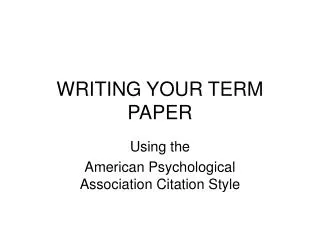
WRITING YOUR TERM PAPER
WRITING YOUR TERM PAPER. Using the American Psychological Association Citation Style . Term Paper Format. Margins should be at minimum 1” (one inch) on all sides. Preferred typefaces: Times New Roman, 12 pt, Courier, 12 pt,.
2.47k views • 26 slides
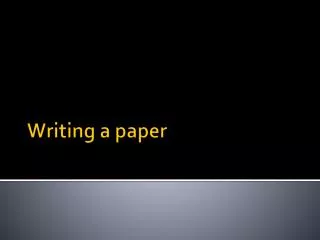
Writing a paper
Writing a paper. Organization. Logical overall organization (e.g., international comparisons, broad US trends, subgroup trends, causal relationships ( scattergrams ). Paragraph organization paragraph addresses one main topic, each topic is fully developed Topic sentence. Concise Writing.
270 views • 11 slides

Term paper. Term paper . Length: Approximately 4 pages Font: Times New Roman 12 Line Spacing: 1.5 Margins: Standard. T opics. Hydrogen Oxygen Iodine Metals Radioactive metals Photosynthesis Vitamins Carbohydrates Alkaloids The Effects o f Radioactivity o n Living Organisms
183 views • 3 slides

Writing a Paper
Writing a Paper. Michalis Faloutsos. Publishing a paper. Having a good idea is not enough You need good and clear writing You need to make clear claims Work needs to be bullet-proof. Typical Conceptual Problems. Missing previous work: deadly Not compare with “ competition ”
267 views • 17 slides

Term Paper. Welcome to the Presentation. Mohammad Alauddin MSS (Government &Politics) MPA( Governance& Public Policy) Deputy Secretary. Special Foundation Training Course For BCS (Health) Cadre. Officers BIAM Foundation, May, 28, 2010. Introduction.
599 views • 18 slides

Term Paper. Phase-I is Due on Tuesday, February 19 in class timing Submit a Hard Copy of your paper (MS word Document) Follow the instructions in “Term Paper Specification†document for Deliverables Make group (3 students) by Friday, February 01
562 views • 31 slides
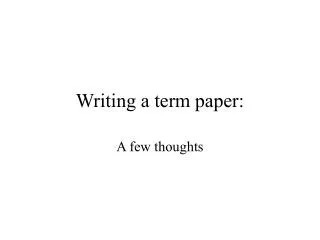
Writing a term paper:
Writing a term paper:. A few thoughts. The most common error. The most common error in term paper is a failure to maintain a focus Your paper should make an argument of some kind, an argument that supports some point
694 views • 12 slides

Term Paper Research and Writing Guidelines
Term Paper Research and Writing Guidelines. De Anza College. Recommended Time Frame. Week 1: Choose a topic, paper proposal Week 2 - 5: Read and take notes Week 6a: Develop a paper outline Week 6b: Write paper. Step 1: Paper Topic Proposal. Spend 1 week to narrow down a topic
330 views • 11 slides

Writing A Term Paper
Writing A Term Paper. What is an essay or term paper?. A piece of academic writing that contains an argument or claim. An argument is a coherent series of statements that are based on some premise and which lead to a conclusion and which is generally intended to persuade
523 views • 37 slides

Writing a Term Paper
You Term Paper writing is not as difficult as you may think. Watch this presentation and find out useful tips for your future writing. More details can be found in the article https://essay-academy.com/account/blog/writing-a-term-paper
432 views • 16 slides
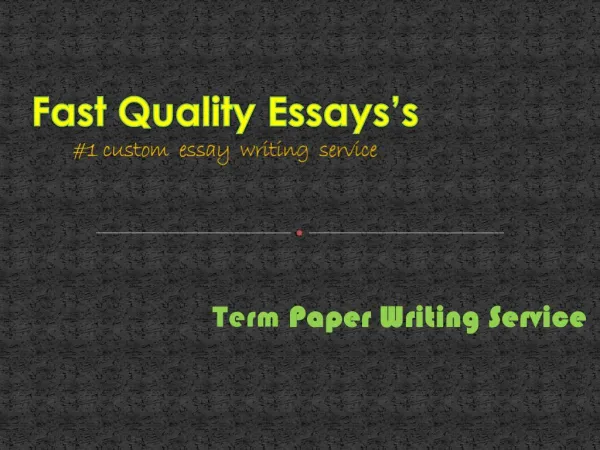
Top Quality Term Paper Writing Service
A term paper is a research paper written by students over an academic term, accounting for a large part of a grade.
153 views • 7 slides

Term paper writing service reviews - A best guide
Term paper writing service reviews is one of the topmost writing help in UK. It will be a best guide for modern students those who are struggling with their term paper work. Don't waste time, choose our service and make a better future.
149 views • 1 slides

Term paper writing service reviews
Students use Essay Writing service at least once for their academic task .This give some tips for you.
143 views • 1 slides

About Our Term Paper Writing Services
Many students experience difficulties in writing a distinct term paper that reveals extensive knowledge and total understanding in a certain topic. <br>
284 views • 14 slides
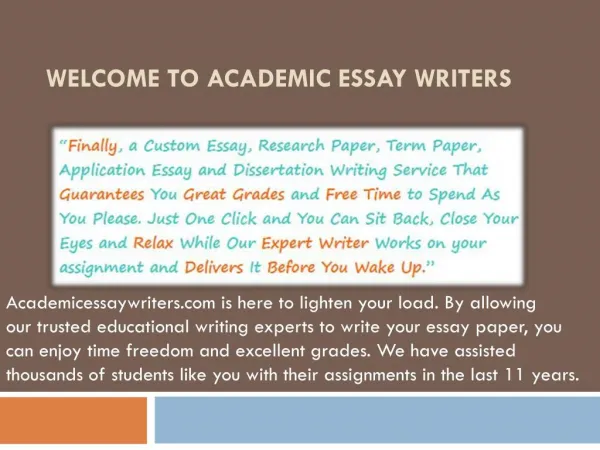
Custom Term Paper Writing Service
Academicessaywriters.com is here to lighten your load. By allowing our trusted educational writing experts to write your essay paper, you can enjoy time freedom and excellent grades. We have assisted thousands of students like you with their assignments in the last 11 years
77 views • 7 slides

Term Paper Writing Service
They are keen to provide on-time delivery of the desired term paper writing that will reap maximum marks for the students.
75 views • 6 slides

Over ten years ago we started our custom writing service aimed to meet any writing needs of any student worldwide. We united a great number of professional writers in various spheres of science to help you with any written academic project.
85 views • 7 slides

Term paper writing services
We offer Best Term paper writing services. We at Eagle writers are keen to ensure that your term paper is in the best format according to your respective colleges or as may be advised by the client. Visit at: https://www.eaglewriters.com/blog/term-paper
54 views • 4 slides
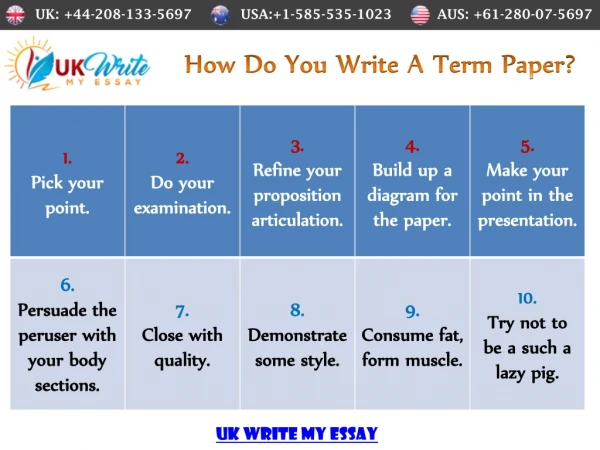
Write A Term Paper
We have a lots of idea and highly expert for all students for write a term paper. If you want term paper writing service please visit here:- https://ukwritemyessay.com
28 views • 2 slides

Term Paper. ECO 5520/5930/6520. It’s early, but …. Several have asked. Deliverable is due Wednesday, March 26. Paper is due Wednesday, April 16. Topic: Data-based Finance Analysis. I am creating a file for your use. You will create hypotheses and test them.
93 views • 5 slides

212 views • 17 slides

Term Paper Writing Service Online- myassignmenthelp.com
Getting professional help from online custom term paper writing services can, no doubt, save a student a lot of time.
118 views • 11 slides

How to Write a Term Paper: A Complete Guide With Examples
You just got your term paper assignment and have no idea what to do or how to start? This guide will navigate you through every step of the process, from idea formation to final editing and proofreading. We will start with outlining, drafting and brainstorming, and get you through the writing part in no time. So, let’s dive into the question of how to write a term paper.
If you want to know everything you will need about term papers, this guide, written by the writers at the best essay writing service will help you along.
Table of Contents
What is a term paper.
A term paper is an academic milestone more so than anything else. As a student, you are tasked with learning and then transmitting that knowledge to others. A term paper is just that, a way to show what you have learnt, and disseminate the knowledge to others. Unlike other types of academic writing , a term paper is more detailed, requires more research, and is generally seen as the hardest piece of written work aside from a thesis.

The aim of a term paper is to showcase your understanding of the subject matter and how well you handle pressure and deadlines. In this context, a term paper proves invaluable. In terms of scope, term papers may zero in on an important historical event – if you’re studying history – a scientific concept, or a contentious argument. The choice hinges on the prompt created by your academic advisor. The typical length of a term paper can stretch to five or seven pages, and is generally the prerequisite to attend end-of-semester examination. But, it is also a part of the weighted grade you’ll receive, which only adds to its importance.
For the average student, writing a term paper takes around two weeks, and is a process many do not fully understand. Term paper starts from a very basic element, a question.
Say your teacher wants you to analyze the arguments for and against US involvement in World War II. How would you start? By asking a question; something like: Why did the US enter the war? Or, why did the US waive its neutrality and entered the war.
This opens the door for you and allows you to find an article or two that then leads to the second step, and so on and so on, until you are done. The problem is many students do not know how the process works, or what skills are needed to get the job done. To write an excellent paper you need to plan carefully, adapt to new conditions, be analytical yet persuasive, and understand how referencing works. In addition, the paper has to be formatted to specifications of your chosen citation style – APA, MLA, Chicago/Turabian, Harvard, etc. This is a lot of work!
What is the Purpose of a Term Paper
At its core, a term paper serves to test your ability to understand arguments and defend them using written constructs within a pre-determined time period. Put simply, it tests your ability to navigate complex ideas when faced with a deadline – something that comes in handy in almost every job you’ll ever have later in life. If you can understand a complex event, a scientific theory, or a debatable stance, based on the directive from your academic mentor, you can manage pretty much anything that is thrown your way.
A typical term paper will be between five to seven pages, and represents the pinnacle of writing tasks in the semester. The process of term paper writing, even when the topic is prescribed, can be an arduous and time-consuming undertaking. To succeed you need meticulous planning, good composition skills, and scrupulous analysis, structure, and edit
Doing the Basics Right Saves You Time
As Seneca famously said, “Luck Is What Happens When Preparation Meets Opportunity.” In short, prepare, prepare, prepare. To create a perfect term paper you need to know, well in advance, how it will look, what will it be about, and how will it be structured. This then allows you to simply fill in the blanks as you go. But, if you start a day before submission, you’re toast – or, you can always ask for help from us J – because the result will be Red Bull frenzy induced compilation of internet’s best hits. And trust me when I say, your teacher has those stored in memory; you’re not the first student to turn a deaf ear on old Seneca….

So, let’s see how to start your term paper:
- Select your topic – If possible choose something that you’re personally interested in. When you choose early, all the good topics are still free, so keep that in mind.
- Research your topic – Once chosen, sit at your computer and run through Google Scholar or your University Library for anything that pops up when you type in your exact topic.
- Create an outline – When you have a basic understanding of the topic, prepare an outline. It’s always going to be fairly standard, so once you get it right, you can re-use whenever you need to in the future.
- Thesis statement – Now starts the tricky part. Just kidding, this is still the Top Lane, we’re not even close to the Jungle. Thesis statements are always pretty similar. Jolt down your guiding question and then, based on what you’ve read, write a one sentence argument. For example, if writing about solar and wind, you might go with: Solar and wind power are the future of energy production because fossil fuels are unsustainable.
- Topics, topic sentences, and paragraphs – Every paragraph starts with a topic sentence that describes what the paragraph is talking about. The easiest way to understand is this. If writing a paper about wind and solar, you would need at least three topic sentences – 1)Wind 2)Solar 3)Benefits of using wind and solar. Naturally, a term paper needs much more than just three, but you get the idea.
- Conclusion – Once you’ve written down the topic sentences and outlined the paper, note your own expectations of what you’ll find in the conclusion. This will help you understand what is happening, and when you’re actually writing the conclusion it will tell you if you were right or wrong.
Pro tip: If all of this is too much for you, there is always the possibility of asking professionals for help. Our team of term paper writers are here to help, so feel free to reach out!
Structure of a Term Paper
As you’ve probably guessed by now, every paper has to have a specific structure. In general, you can expect to have at least three parts – introduction, body, and a conclusion. However, longer papers may need several sub-sections, perhaps even an abstract or a summary, and a page dedicated to bibliography.
A typical term paper has three to five body paragraphs that form the backbone of your arguments and analytical discourse. A bibliography is always needed, even if your sources predominantly comprise course materials or excerpts from consulted textbooks. Depending on the chosen style, you will need either a Works Cited page (MLA), a Reference page (APA) or a Bibliography (Harvard, Chicago). Given its pivotal role in determining your final course grade, make sure to adhere to the highest writing and editing standards.
Term Paper Outline
- Title page – this is where you enter your name, teacher name, school, class, and date. The formatting will depend on your chosen style
- Introduction – Introduction sets the stage for your arguments. This is where you present statistics, define helpful terms, and finally present your thesis statement. IMPORTANT: Thesis statement is always the last sentence in the introduction.
- Body 1: Historical setting or development
- Body 2: Current state of knowledge about the problem
- Body 3: Main argument and potential implications
- Body 4: Argument for
- Body 5: Argument against
- Body 6: Summary
- Conclusion : Bring all of the body arguments together and restate your thesis statement.
- Bibliography : Provide references for all sources cited in the term paper using the style of your choice
Now let’s get to the nitty gritty of the writing process.
Topic Selection – In most cases teachers or instructors will provide students with a list of pre-approved topics to choose from. But, in some cases you will get the opportunity to choose for yourself. This is both a blessing and a curse, because it can lead you into a deep pit of despair if you are not careful.
Length – Every paper will have an assigned length. You should never go under the minimum or the maximum word/page count, as that will take points away from your final score. If the prompt asks for 10 pages, write that.
Sources – Consult your school library, Google Scholar, and any other database that has access to journals and books on your topic.
Simplify – While it is admirable to be able to write in a high-brow voice, it’s much better to use plain language as much as possible, but staying within the confines of academic jargon. No don’t’s, couldnt’s, or should’ve. If something is too complicated to explain simply, you do not understand it properly. Ask for clarification.
Do not be afraid to wander – Choosing a common topic may be a safe bet, but your teacher will grade you higher if you take a topic nobody else even though about. Brownie points are there for the taking. Just make sure you know what you’re talking about!
Don’t overextend – While the entire combined histories of all monastic orders may seem like an interesting topic (well, to us at least), it is waaaaaaay too broad to cover in 5 or 10 pages. Heck, that would probably take an entire compendium with multiple volumes. In short, don’t be a megalomaniac and choose a topic that fits in 5 pages.

How to Write a Term Paper: The Writing Process
Before starting your write up, the teacher will expect a proposal. This is a very short summary of the topic, your thesis statement, and a few sources. The goal is to present a topic that you can defend and ask the teacher to approve it.
So how do you write a proposal? Start by writing down your thesis statement and guiding question. Then identify three to four sources and jolt down key statistics and pieces of information that are linked to your thesis statement. The goal is to show you’ve done the work. The proposal will generally have a full outline (see above) so that the teacher knows what you are planning to do. If you explain what the topic is and why it is important in writing , the teacher will accept the proposal.
Introduction, well, Introduces the Term Paper
Your essay has to start strong, which is why 99.99% of all introductions start with a hook that captivates the audience. A hook can be anything, a statistic (like 40% of people in the US have no savings whatsoever, which means around 140 million people are completely broke – now that’s a hook, line, and sinker).
Once you know the reader is hooked, you present a brief overview of the topic you will discuss. This is where you bring statistics, data, and broader theories or concepts that may relate.
The end of the introduction is always reserved for the thesis statement, which is the last sentence of the introduction.
Try to be concise – not more than ¾ of a page (cca 200-250 words), but detailed enough so that the reader understands what the paper is about.
Writing the Body Sections
When you are certain you can understand the concepts and arguments presented in the literature, it’s time to write your body paragraphs.
The goal is to provide the reader with enough context and argumentation to prove your point. So, if you’re writing about the advantages of nuclear energy, you have to provide evidence from the literature as well as a thorough analysis of all benefits and drawbacks. The goal is to be as objective as possible, while ensuring your results are accurate.
Do not dwell on too much detail, you cannot fit all of the information in a 5 – 10 page paper. Isolate the most important pieces of evidence, maybe 3-4 and focus on those.
As a rule of thumb, you will aim for 4 – 5 body paragraphs minimum, but in most cases you will need more. The first section should be the literature review, where you analyze state-of-the-art of the topic you are writing about.
Following the literature review is your analysis, which draws from the information you’ve collected. It’s important to note, do not try and make up new stuff, or draw conclusions in this section. Simply analyze and summarize the findings in your own voice.
The last paragraph of the body section can be your own summary, where you present a different opinion. Be concise and do not go into too much detail, simply note if you think there are any discrepancies in the literature.
Remember : Always start your paragraphs with a topic sentence and try to contain the information within the paragraph to the topic.
Writing the Conclusion
Conclusion is the most important part of the term paper, even though many do not give it enough attention. This is where you put everything you’ve written together and summarize key findings.
Important : Conclusion is not the place to add new information or knowledge!
To write a good conclusion keep in mind your initial research question and thesis statement. The goal of the term paper is to answer the question and prove your thesis statement is correct. Has your paper done this? Write it down and explain why or why not your initial proposal was correct. A thesis statement can be wrong, and you must acknowledge this in your conclusion.
In the conclusion:
- Summarize your findings
- Discuss implications for future reseasrch
Editing and Finalization
The final word of the conclusion has been written, references added and alphabetized, the paper and the title page formatted. You are finally done. Or, maybe not! Now is the time for the final edit.
Teachers, above everything else, hate reading papers with spelling mistakes and poor grammar. To make sure your paper does not annoy the teacher (you don’t want a lower grade), make sure it is completely free of any errors.
The best way to do this is by using a machine learning tool combined with close reading on your own. The machine will weed out the glaring errors, and you will finish the job.
Read through the draft carefully. Remove any fluff or excess words that add nothing to the argument. You will likely find several sentences you will want to change. Do this now. Once done, start the second read-through.
In this read-through you will hone in on the arguments. Do they make sense? Are statistics properly cited, and do you sound coherent? If the answer is no, you will want to fix the mistakes until satisfied.
Now, finally, you are done! Congratulations. Pat yourself on the back. Oh, wait, we forgot about the abstract!
Abstract Comes First, or Last
In no uncertain terms, do not write the abstract before you’ve completed the term paper. This is always the last part of the writing process, but strangely enough the one your paper starts with. Go figure.
When you do get to this stage, use our secret formula. Well, it’s not really secret but we like to think so. The abstract needs three parts to work well, the introduction, the method/procedure, and the conclusion/findings. Depending on the topic these will vary slightly but you will always find them in an abstract.
Introduce your topic and what you plan to do in two to three sentences.
Describe what method you will use – such as literature review, an experiment, or something else. Two to three sentences.
Define the results you obtained after using the method. Two to three sentences.
Remember : The abstract should be between 120 and 200 words in length, no more is needed.
No, they are not. A research paper is an original piece of writing that comes after some type of original research has been done. Maybe you’ve found a new civilization during a dig, or a new chemical element. The research paper is meant to publicize this finding so other scientists can critique, refute, or confirm its validity. A term paper is a much simpler version that requires no original research. But, a term paper is your preparation for writing a research paper later in life.
This will depend on your teacher. In many cases, you will get a pre-defined format to follow, such as APA, MLA, or Chicago. If not, we recommend using APA or Harvard, as they are relatively simple to learn and have a ton of resources to help you along.
It is important to remember you are not writing a book, so keep the topic narrow. For example, if writing about renewable energy, choose only one type of energy or just one region. Do not try to cram everything into 5-10 pages; it won’t work.
Writing a term paper is certainly a challenge, but it is also manageable if you dedicate yourself to the process. Prepare well in advance, read a lot, and do not be afraid to ask for help if you get stuck. Your teachers are paid to help you, so email them if you get stuck. Above everything, make sure you are interested in the topic, as that will make the process so much easier.
Related Posts

10 Tips To Study Effectively

How To Buy Essays Online? A Safety-First Guide For Students!
- Preferences

How to Write a Term Paper - PowerPoint PPT Presentation

Something went wrong! Please try again and reload the page.
How to Write a Term Paper
This presentation will be useful for those students who have no idea on how to write a term paper. more advice you can find in the article – powerpoint ppt presentation.
- Created by Essay-Academy.com
- A term paper is a paper usually written over an academic term (at the end of a semester). If you want to write a good term paper, you need a lot of time.
- You also need to make a plan of writing your research paper.
- https//essay-academy.com
PowerShow.com is a leading presentation sharing website. It has millions of presentations already uploaded and available with 1,000s more being uploaded by its users every day. Whatever your area of interest, here you’ll be able to find and view presentations you’ll love and possibly download. And, best of all, it is completely free and easy to use.
You might even have a presentation you’d like to share with others. If so, just upload it to PowerShow.com. We’ll convert it to an HTML5 slideshow that includes all the media types you’ve already added: audio, video, music, pictures, animations and transition effects. Then you can share it with your target audience as well as PowerShow.com’s millions of monthly visitors. And, again, it’s all free.
About the Developers
PowerShow.com is brought to you by CrystalGraphics , the award-winning developer and market-leading publisher of rich-media enhancement products for presentations. Our product offerings include millions of PowerPoint templates, diagrams, animated 3D characters and more.
Free AI Presentation Maker for Generating Projects in Minutes
- Generate ready-to-use presentations from a text prompt.
- Select a style and Visme’s AI Presentation Maker will generate text, images, and icon.
- Customize your presentation with a library of royalty-free photos, videos, & graphics.
Generate a presentation with AI

Brought to you by Visme
A leading visual communication platform empowering 27,500,000 users and top brands.

Presentations Engineered With Visme’s AI Presentation Maker
Ai presentation prompt 1.
Craft a presentation outlining a leading company’s cutting-edge innovations in AI-powered hardware, emphasizing their impact on enhancing workplace productivity and efficiency.
AI Presentation Prompt 2
Generate a comprehensive presentation highlighting the latest digital marketing trends, focusing on strategies for enhancing brand visibility and customer engagement across diverse platforms.
AI Presentation Prompt 3
Create a detailed presentation elucidating a company’s diversified investment portfolio, emphasizing its robust performance, risk mitigation strategies, and the potential for sustainable long-term growth.
AI Presentation Prompt 4
Develop a compelling presentation showcasing a company’s groundbreaking medical devices and software solutions, emphasizing their role in revolutionizing patient care, treatment efficacy, and healthcare accessibility worldwide.

How it works
How to generate AI presentations with Visme
Save time and create beautiful designs quickly with Visme AI Designer. Available inside the Visme template library, this generator tool is ready to receive your prompts and generate stunning ready-to-use presentations in minutes.

- Log in to the Visme dashboard, and open the template library by clicking on Create New button -> Project -> Presentations. Inside the template library, scroll down and click on the Generate with AI option.
- In the popup that opens, type in a prompt and describe in detail what aspects your presentation should feature. If you don’t provide enough information, chatbot will ask you follow-up questions.
- Visme Chatbot will suggest template styles; choose the most relevant for your presentation, and wait for the AI to create the design. Preview, regenerate or open your project in the Visme editor.
- Customize your project in Visme: Pick a color theme or create your own, edit text, and use assets from Visme’s royalty-free library of photos, videos, and graphics, or create your own with AI tools.
Features of the AI Presentations Maker
Ready-to-use presentations in minutes.
Starting is often the hardest part of a project. Visme’s free AI presentation maker helps you overcome this block and generates results within minutes. It gives you a headstart and a good first draft that is ready-to-use with minimal or no customization.

Customize every part of your presentation
Visme editor is easy to use and offers you an array of customization options. Change the color theme of your presentation, text, fonts, add images, videos and graphics from Visme royalty-free library of assets or generate new ones with AI image generator, AI image touchup tools, or add your own. For more advanced customization, add data visualizations, connect them to live data, or create your own visuals.

Add your branding
Stay on-brand even with AI-generated presentations. Quickly and easily set up your brand kit using AI-powered Visme Brand Wizard or set it up manually. Use your brand colors and fonts in AI-generated presentations. Add your logo and upload your brand assets to make a presentation match your company’s branding.
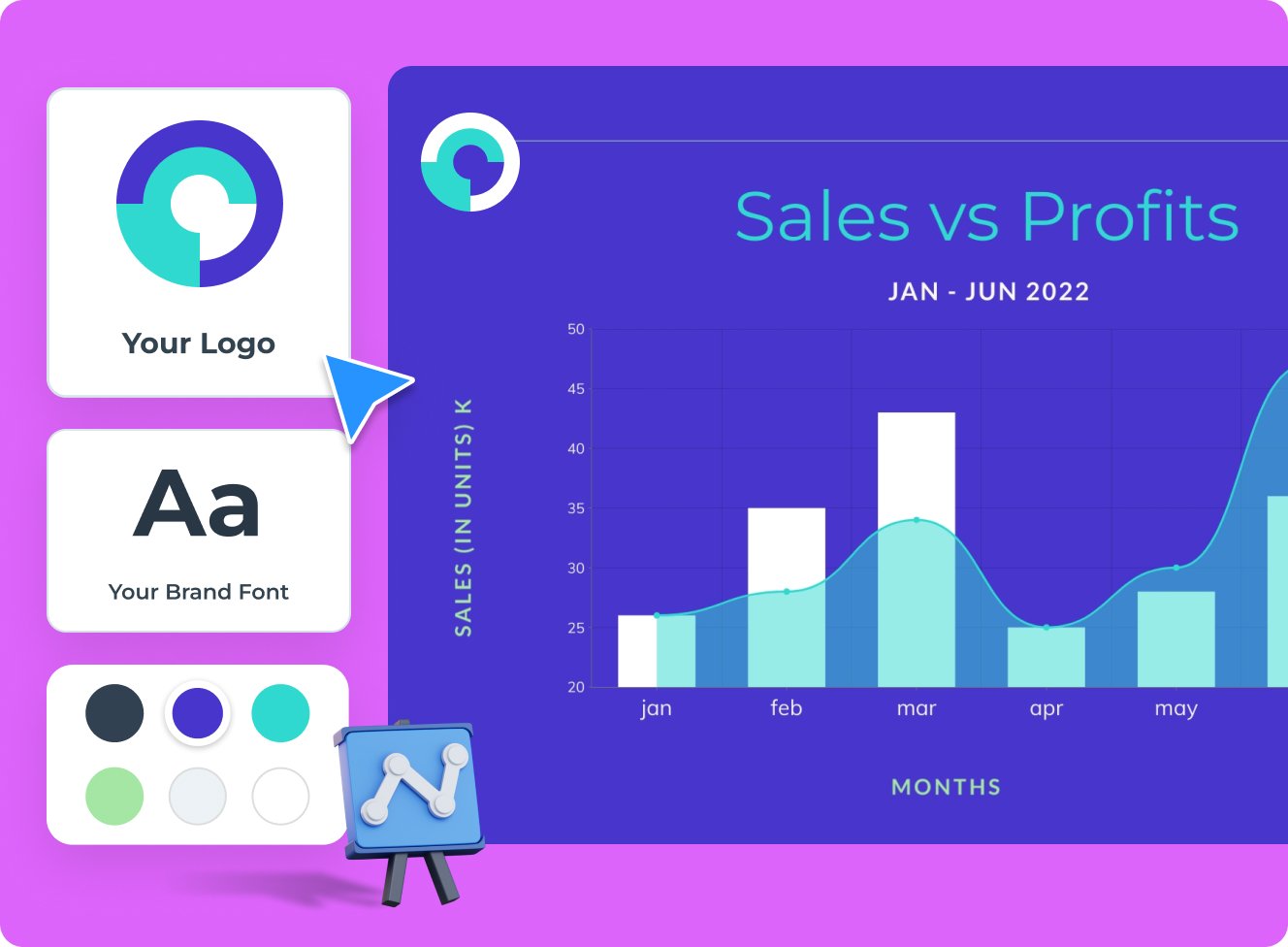
Download, share or schedule your presentation
Share your presentations generated with Visme AI Designer in many ways. Download them in various formats, including PPTX, PDF and HTML5, present online, share on social media or schedule them to be published as posts on your social media channels. Additionally, you can share your presentations as private projects with a password entry.
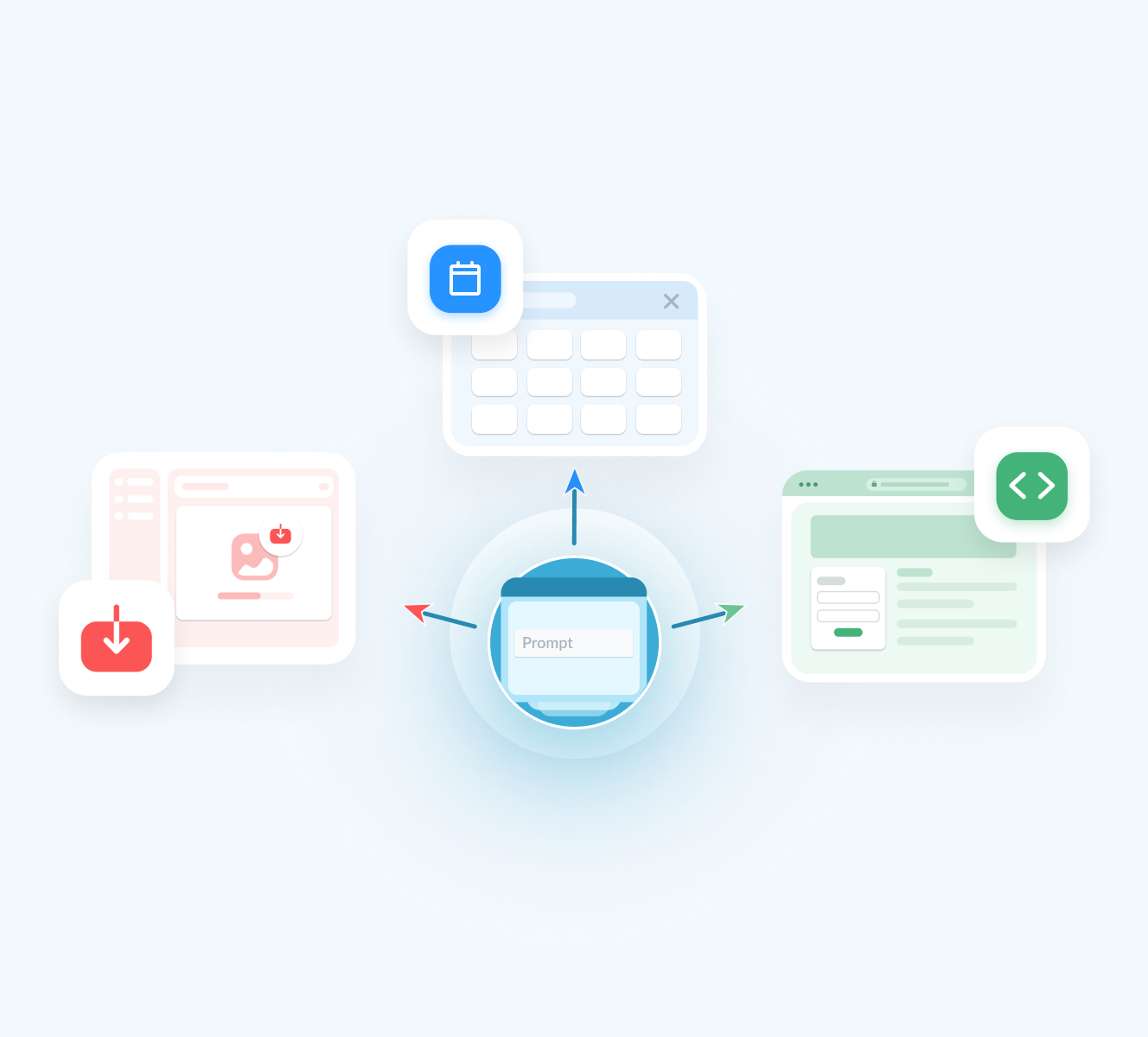
More than just an AI Presentation Maker

Beautify your content
Unique Elements & Graphics
Browse through our library of customizable, one-of-a-kind graphics, widgets and design assets like icons, shapes, illustrations and more to accompany your AI-generated presentations.

Visualize your data
Charts & Graphs
Choose from different chart types and create pie charts, bar charts, donut charts, pyramid charts, Mekko charts, radar charts and much more.

Make it engaging
Interactivity
Share AI-generated presentations online with animated and interactive elements to grab your audience’s attention and promote your business.
More AI tools in Visme
Ai image generator.
The Visme AI Image generator will automatically create any image or graphic. All you need to do is write a prompt and let AI magic do the rest.

Visme AI Writer helps you write, proofread, summarize and tone switch any type of text. If you’re missing content for a project, let AI Writer help you generate it.
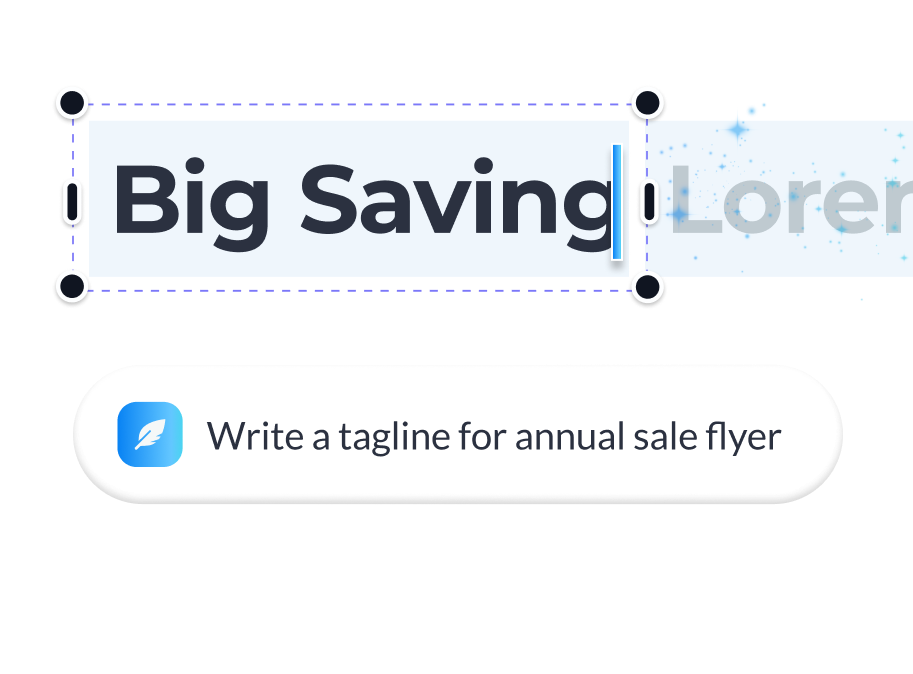
Save yourself hours of work with AI Resize. This feature resizes your project canvas and adjusts all content to fit the new size within seconds.

AI TouchUp Tools
The Visme AI TouchUp Tools are a set of four image editing features that will help you change the appearance of your images inside any Visme project. Erase and replace objects that you don’t want in your photos.

The Brand Wizard
The AI-based Visme Brand Wizard populates your brand fonts and styles across a beautiful set of templates.

Make the most of Visme’s features
Choose the perfect visual from our extensive photo and video library . Search and find the ideal image or video using keywords relevant to the project. Drag and drop in your project and adjust as needed.
Incorporate 3D illustrations and icons into all sorts of content types to create amazing content for your business communication strategies. You won’t see these 3D designs anywhere else as they’re made by Visme designers.
When you share your Visme projects, they’ll display with a flipbook effect . Viewers can go from page to page by flipping the page like a digital magazine. If you don’t want the flipbook effect, you can disable it and share as a standard project.
Remove the background from an image to create a cutout and layer it over something else, maybe an AI-generated background. Erase elements of the image and swap them for other objects with AI-powered Erase & Replace feature.
Create scroll-stopping video and animation posts for social media and email communication. Embed projects with video and animation into your website landing page or create digital documents with multimedia resources.
With Visme, you can make, create and design hundreds of content types . We have templates for digital documents, infographics, social media graphics, posters, banners, wireframes, whiteboards, flowcharts.
Design and brainstorm collaboratively with your team on the Visme whiteboard . Build mind maps and flowcharts easily during online planning and strategy sessions. Save whiteboards as meeting minutes and ongoing notes for projects.
Edit your images , photos, and AI image-generated graphics with our integrated editing tools. On top of the regular editing features like saturation and blur, we have 3 AI-based editing features. With these tools, you can unblur an image, expand it without losing quality and erase an object from it.
Frequently Asked Questions (FAQs)
How can i get better results with the ai presentations maker.
Like any AI generator from a text tool, the prompt is everything. To get better results with the AI Presentation maker, you need better prompts. Write the prompt to be as detailed as possible. Include all the content topics you want the presentation to cover. As for style elements, there’s no need to include it in the prompt. Focus on choosing the style that you like from the Chatbot suggestions. Try to select the style that already features the color palette and shapes that you like. AI will change icons and photos based on text it generates.
How many AI Presentations can I generate?
Visme AI Presentation maker is available in all plans with higher credits/usage available in Premium plans. Note: AI credits are spread amongst all AI features. So if you use other AI features, your credits will be deducted.
Is the Visme AI Designer a third-party API?
No, Visme AI Presentation maker was developed in-house and is a unique tool. However, it does use third-party APIs: ChatGPT and Unsplash.
This website uses cookies to improve the user experience. By using our website you consent to all cookies in accordance with our cookie policies included in our privacy policy.
Unfortunately we don't fully support your browser. If you have the option to, please upgrade to a newer version or use Mozilla Firefox , Microsoft Edge , Google Chrome , or Safari 14 or newer. If you are unable to, and need support, please send us your feedback .
We'd appreciate your feedback. Tell us what you think! opens in new tab/window
CRediT author statement
CRediT (Contributor Roles Taxonomy) was introduced with the intention of recognizing individual author contributions, reducing authorship disputes and facilitating collaboration. The idea came about following a 2012 collaborative workshop led by Harvard University and the Wellcome Trust, with input from researchers, the International Committee of Medical Journal Editors (ICMJE) and publishers, including Elsevier, represented by Cell Press.
CRediT offers authors the opportunity to share an accurate and detailed description of their diverse contributions to the published work.
The corresponding author is responsible for ensuring that the descriptions are accurate and agreed by all authors
The role(s) of all authors should be listed, using the relevant above categories
Authors may have contributed in multiple roles
CRediT in no way changes the journal’s criteria to qualify for authorship
CRediT statements should be provided during the submission process and will appear above the acknowledgment section of the published paper as shown further below.
Term | Definition |
|---|---|
Conceptualization | Ideas; formulation or evolution of overarching research goals and aims |
Methodology | Development or design of methodology; creation of models |
Software | Programming, software development; designing computer programs; implementation of the computer code and supporting algorithms; testing of existing code components |
Validation | Verification, whether as a part of the activity or separate, of the overall replication/ reproducibility of results/experiments and other research outputs |
Formal analysis | Application of statistical, mathematical, computational, or other formal techniques to analyze or synthesize study data |
Investigation | Conducting a research and investigation process, specifically performing the experiments, or data/evidence collection |
Resources | Provision of study materials, reagents, materials, patients, laboratory samples, animals, instrumentation, computing resources, or other analysis tools |
Data Curation | Management activities to annotate (produce metadata), scrub data and maintain research data (including software code, where it is necessary for interpreting the data itself) for initial use and later reuse |
Writing - Original Draft | Preparation, creation and/or presentation of the published work, specifically writing the initial draft (including substantive translation) |
Writing - Review & Editing | Preparation, creation and/or presentation of the published work by those from the original research group, specifically critical review, commentary or revision – including pre-or postpublication stages |
Visualization | Preparation, creation and/or presentation of the published work, specifically visualization/ data presentation |
Supervision | Oversight and leadership responsibility for the research activity planning and execution, including mentorship external to the core team |
Project administration | Management and coordination responsibility for the research activity planning and execution |
Funding acquisition | Acquisition of the financial support for the project leading to this publication |
*Reproduced from Brand et al. (2015), Learned Publishing 28(2), with permission of the authors.
Sample CRediT author statement
Zhang San: Conceptualization, Methodology, Software Priya Singh. : Data curation, Writing- Original draft preparation. Wang Wu : Visualization, Investigation. Jan Jansen : Supervision. : Ajay Kumar : Software, Validation.: Sun Qi: Writing- Reviewing and Editing,
Read more about CRediT here opens in new tab/window or check out this article from Authors' Updat e: CRediT where credit's due .

IMAGES
VIDEO
COMMENTS
The term paper. 1. The document provides guidelines for formatting a term paper, including formatting for the title page, table of contents, introduction, research methodology, findings, and conclusions sections. 2. Specific formatting guidelines are provided for font, margins, spacing, pagination, and paragraph justification for each section. 3.
4. Write your abstract. Because the abstract is a summary of your entire paper, it's usually best to write it after you complete your first draft. Typically, an abstract is only 150-250 words, so focus on highlighting the key elements of your term paper like your thesis, main supporting evidence, and findings.
Term Paper. Definition: Term paper is a type of academic writing assignment that is typically assigned to students at the end of a semester or term. It is usually a research-based paper that is meant to demonstrate the student's understanding of a particular topic, as well as their ability to analyze and synthesize information from various sources.. Term papers are usually longer than other ...
Creating a PowerPoint presentation for a research paper involves several critical steps needed to convey your findings and engage your audience effectively, and these steps are as follows: Step 1. Understand your audience: Identify the audience for your presentation. Tailor your content and level of detail to match the audience's background ...
A term paper is generally structured with an opening introduction, followed by several body paragraphs, and culminates with a conclusion. It articulates a central thesis statement, bolstered by corroborative evidence and critical analysis. The writing is formal in nature, adheres to a designated formatting style like APA or MLA, and is ...
Presentation Transcript. What is an essay or term paper? • A piece of academic writing that contains an argument or claim. • An argument is a coherent series of statements that are based on some premise and which lead to a conclusion and which is generally intended to persuade • A Claim, in academic terms, is something that is asserted to ...
4. Writing a Body of Your Term Paper Don't start writing a body of your term paper before you do all the previous steps (especially the third step where you have to analyze the literature). If you make a good analysis of the enough amount of different sources connected with your topic, there will be no serious problems with writing a body of ...
They are perfect for presenting your research paper! First of all, because we have included all the necessary sections of this type of work, such as hypothesis, objectives, methodology, analysis and the conclusions of the paper. The second reason is that the formal style will help you present your content clearly and concisely.
The volume determines which approach you take to writing. For example, if your paper is short, you need to state your thoughts concisely and clearly, going straight to the point. If it is long, do not fill the pages with hot air, but try to do thorough research and look at the issue from different angles.
Body Paragraphs. As a rule, in writing college term papers, one must write down several subheadings and headings to divide ideas and arguments into several (at least four) paragraphs. As done below, each body paragraph should contain one idea and a strong topic sentence. Heading 1: History of the argument and background.
As you can see in our "Term Paper Format" section, you can give titles to each section of your future paper. Also, we recommend you to add topic sentences to each section - this will ease the writing process. Create a calendar. Divide the paper writing process into several steps and list them in your calendar.
The Do's and Don'ts of Term Paper Writing. Do's: Don'ts: Write down every idea you have, even if there's no structure to them. Just record any phrases, tips, quotes or thoughts you come across. This is an outstanding way to collect a lot of material. Follow your outline, but don't be a slave to it.
Presentation Transcript. WRITING YOUR TERM PAPER Using the American Psychological Association Citation Style. Term Paper Format • Margins should be at minimum 1" (one inch) on all sides. • Preferred typefaces: Times New Roman, 12 pt, Courier, 12 pt,. • Pages are numbered starting with title page, and including reference page.
Writing a term paper isn't just about summarizing facts. It requires a blend of organization, deep research, and the art of presenting your findings in a way that's both clear and analytical. This means structuring your arguments logically, citing relevant sources, and critically evaluating the information you've gathered. ...
The first way of this problem solution is. choosing one of the topics, thinking that you. will be interested in it during the process of. writing your term paper. 1.2. The second way of. this problem solution is reformulating (or. narrowing) the topic (in the case if you know. exactly what you will write about). 1.3.
1. Create a script for your presentation. Although you could write everything out, it's best to use notes to jog your memory -- you'll sound more like you're talking and be able to make more eye contact. [4] Only have one point per notecard -- that way you won't end up searching the notecard for your information.
Mission. The Purdue On-Campus Writing Lab and Purdue Online Writing Lab assist clients in their development as writers—no matter what their skill level—with on-campus consultations, online participation, and community engagement. The Purdue Writing Lab serves the Purdue, West Lafayette, campus and coordinates with local literacy initiatives.
Writing a term paper Sigurd Allern, spring 2006. The Five Paragraph Essay • 1) Introducing the reader to the topic. Make it clear and limited. Present your thesis and subtopics. • 2-4: Restatements of the three supporting ideas presented in the first paragraph.
Topics, topic sentences, and paragraphs - Every paragraph starts with a topic sentence that describes what the paragraph is talking about. The easiest way to understand is this. If writing a paper about wind and solar, you would need at least three topic sentences - 1)Wind 2)Solar 3)Benefits of using wind and solar.
It also invites critical engagement with your work, which in turn enables you to improve your writing and thinking. Because many presentations include visual elements (e.g. Power Point), this handout offers guidelines for converting a written paper into a talk and creating visual material that is appropriate for your topic.
1. Selecting a Topic. Usually students choose a theme from the list of. themes, but you also can create your own topic. In any case, you have to discuss a topic of your. term paper with your instructor. 4. 2. Reading A Lot Of Literature Connected with.
Like any AI generator from a text tool, the prompt is everything. To get better results with the AI Presentation maker, you need better prompts. Write the prompt to be as detailed as possible. Include all the content topics you want the presentation to cover. As for style elements, there's no need to include it in the prompt.
CRediT author statement. CRediT (Contributor Roles Taxonomy) was introduced with the intention of recognizing individual author contributions, reducing authorship disputes and facilitating collaboration. The idea came about following a 2012 collaborative workshop led by Harvard University and the Wellcome Trust, with input from researchers, the ...